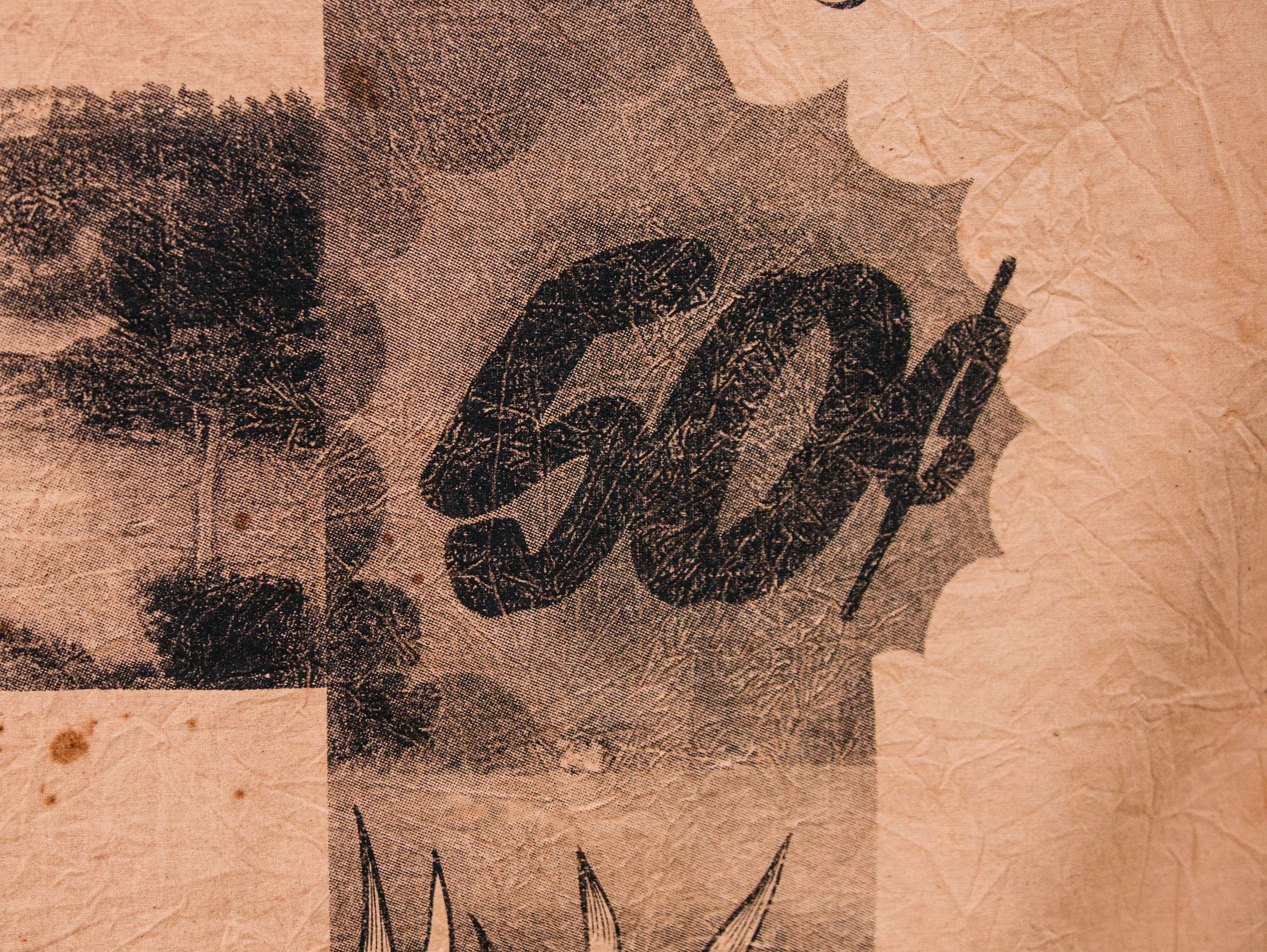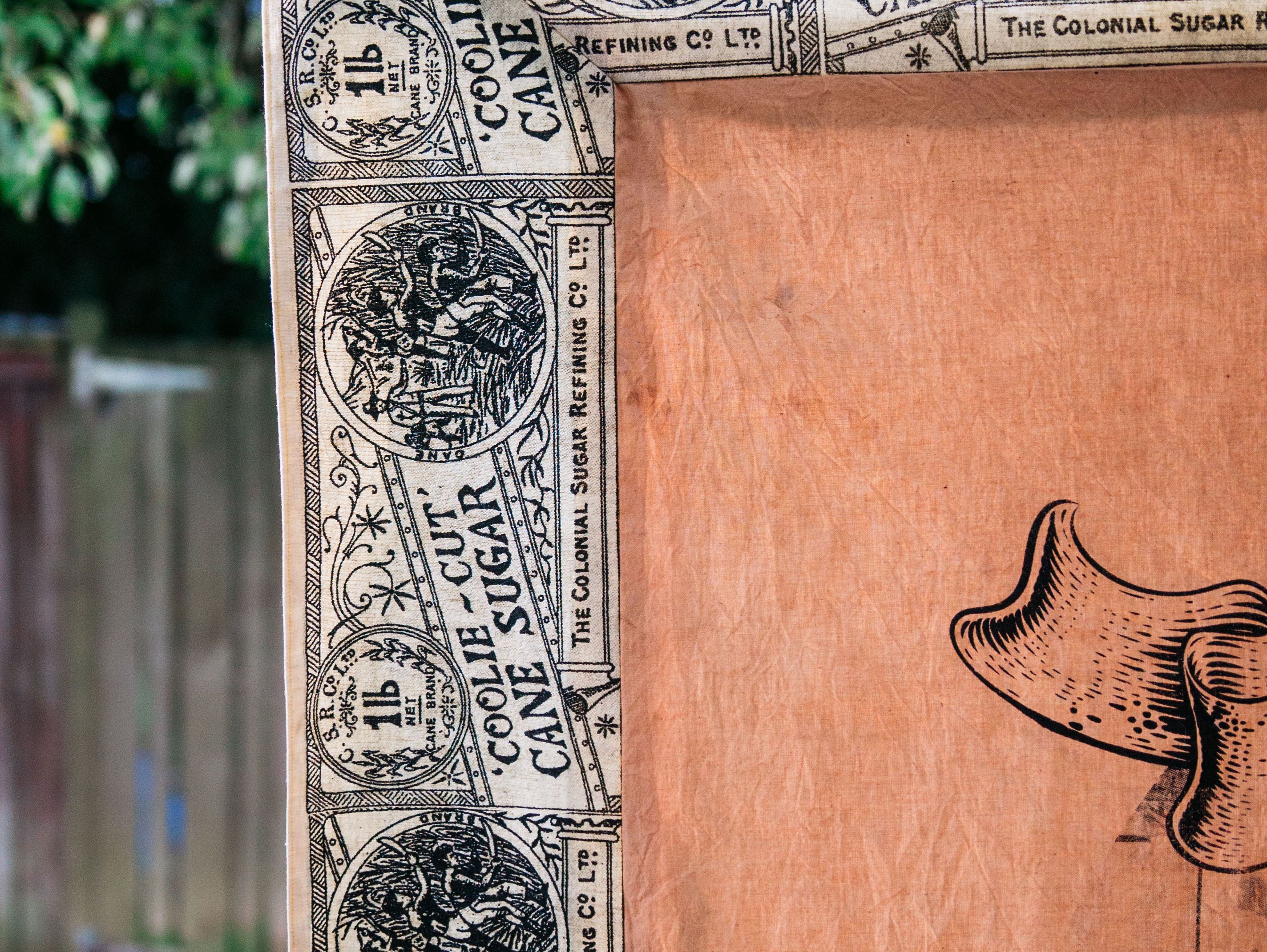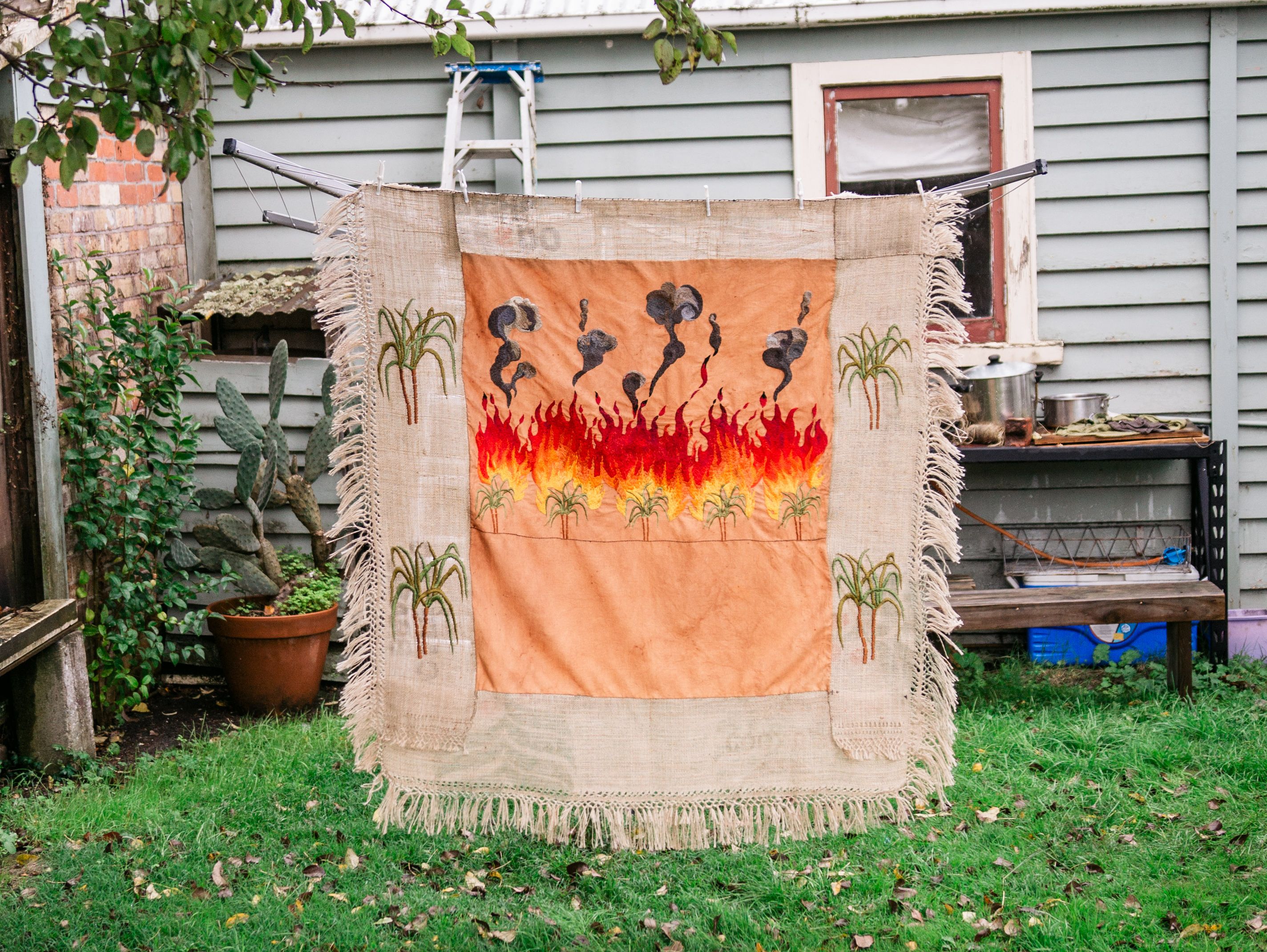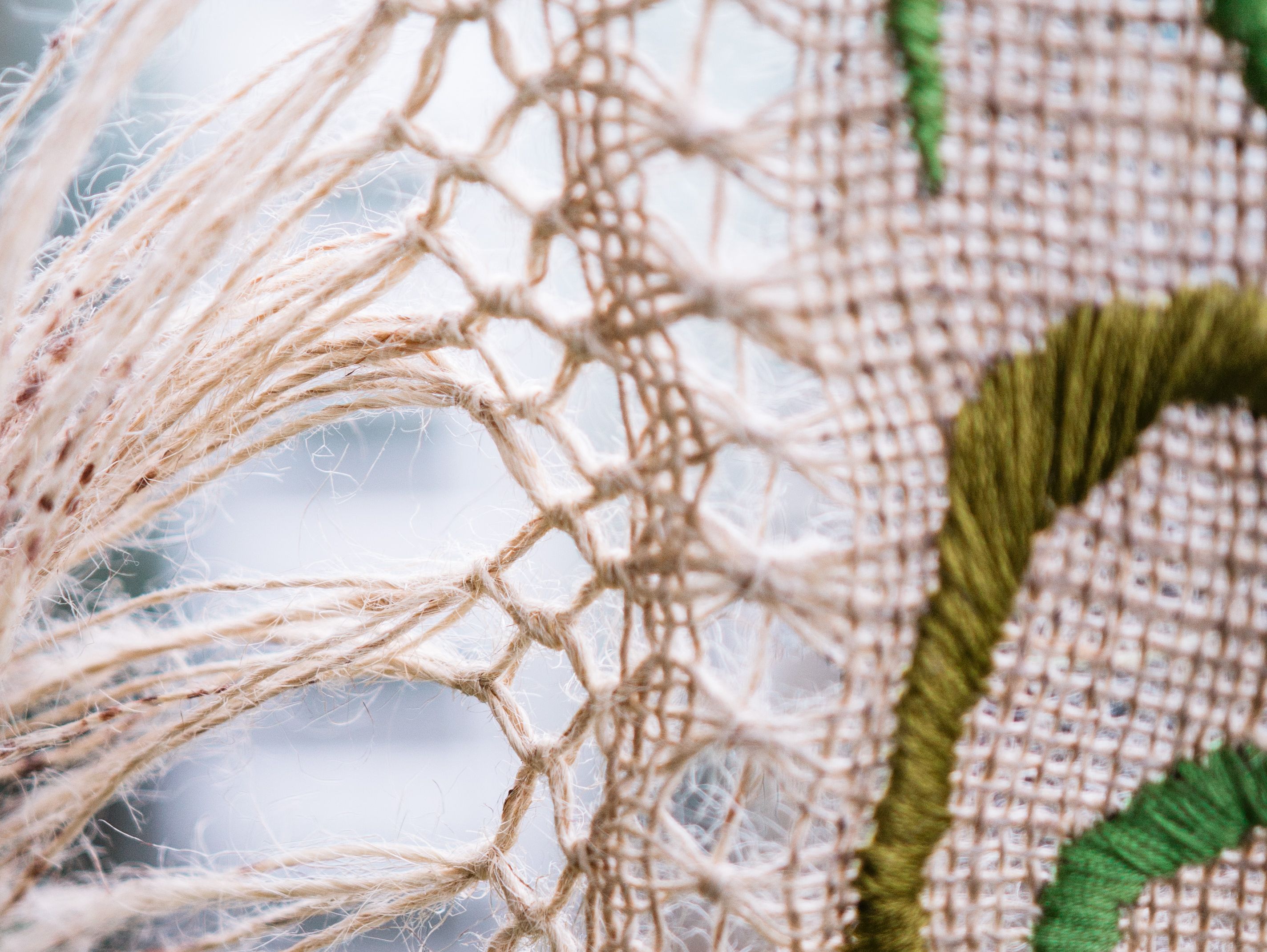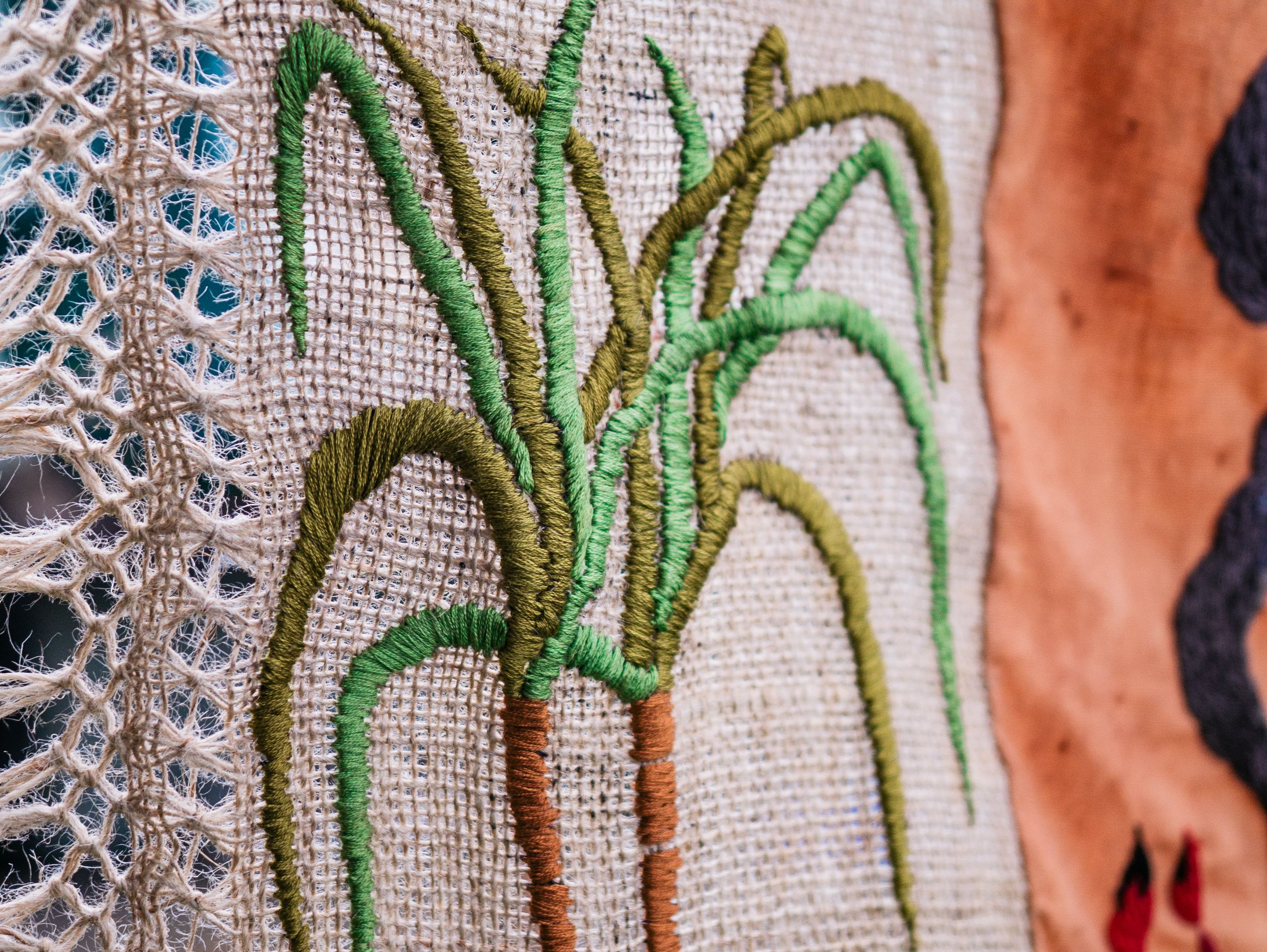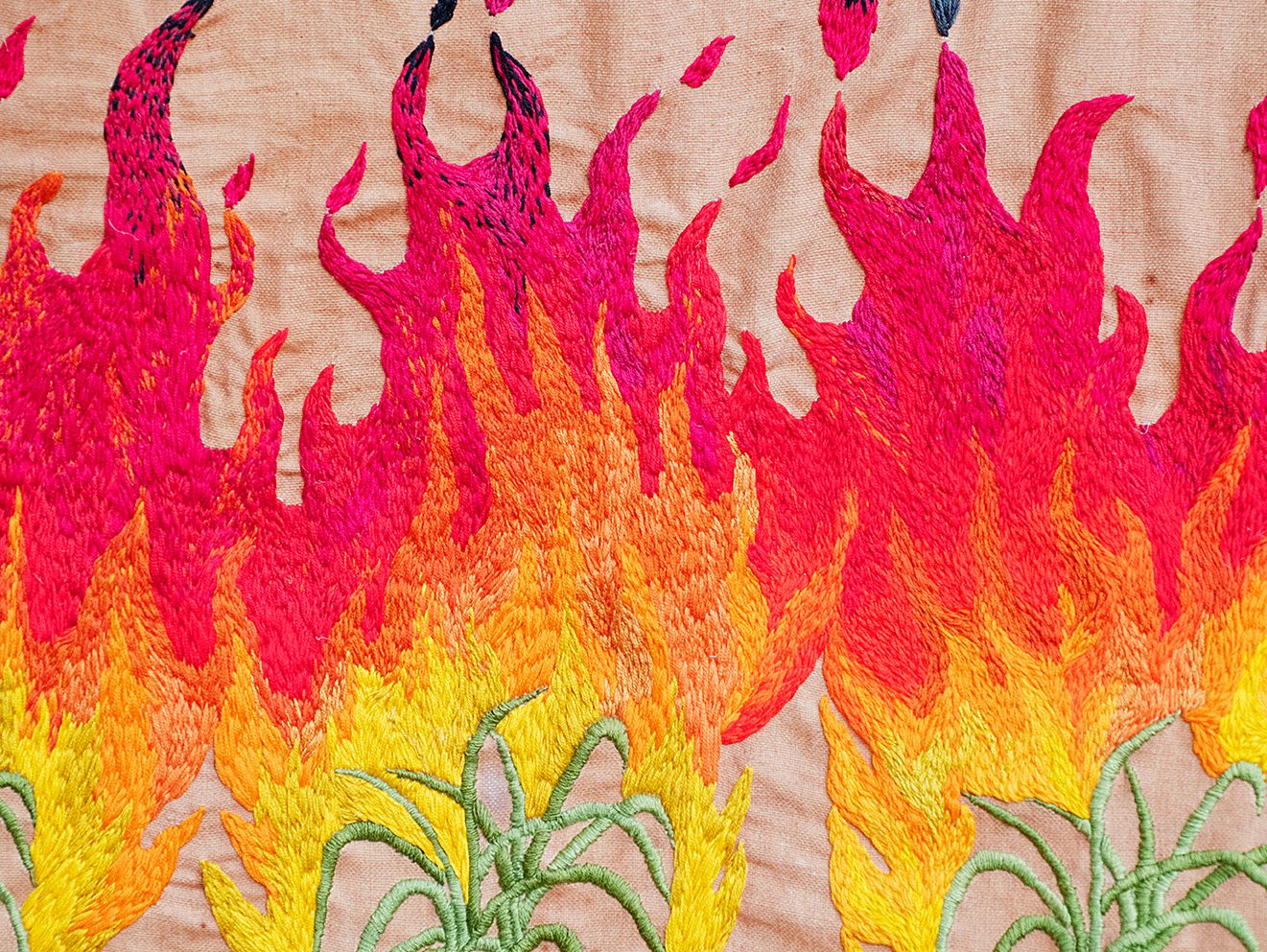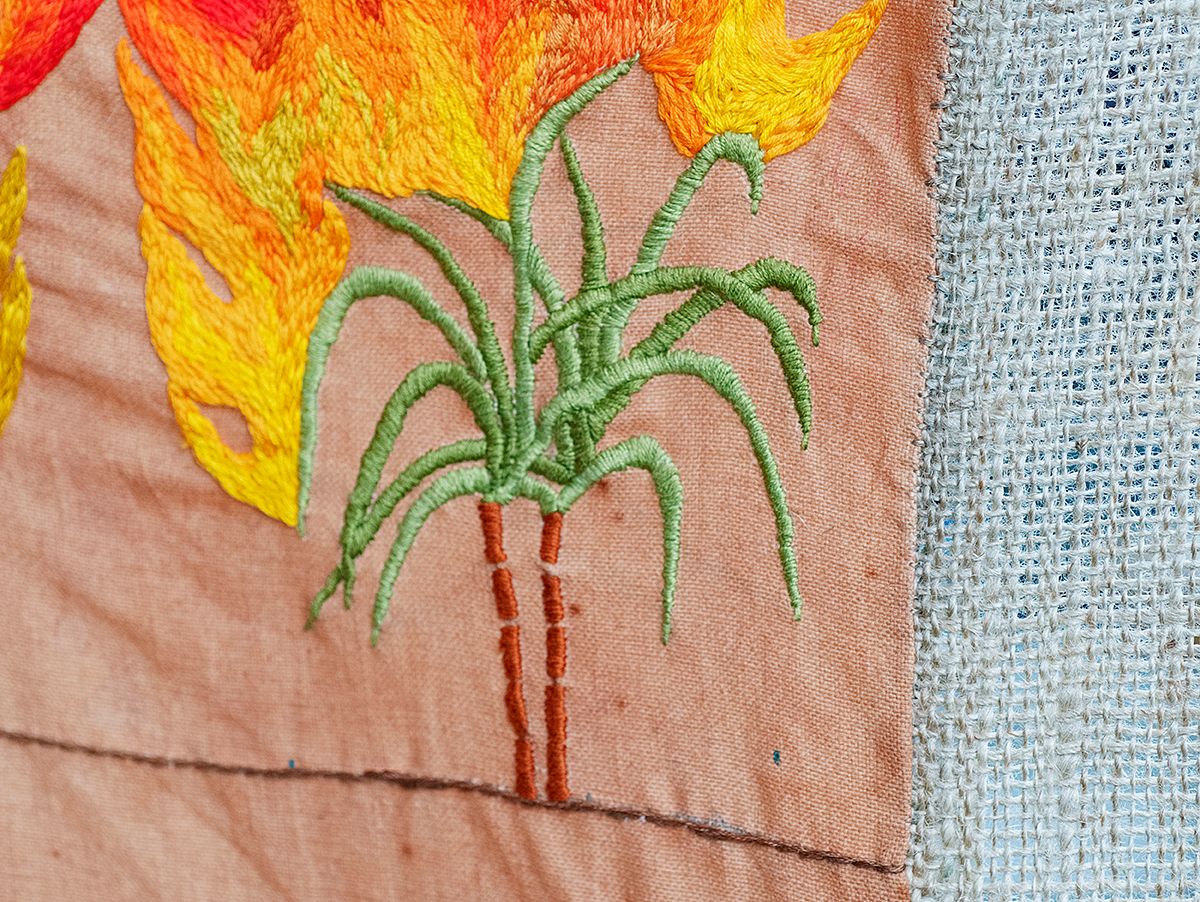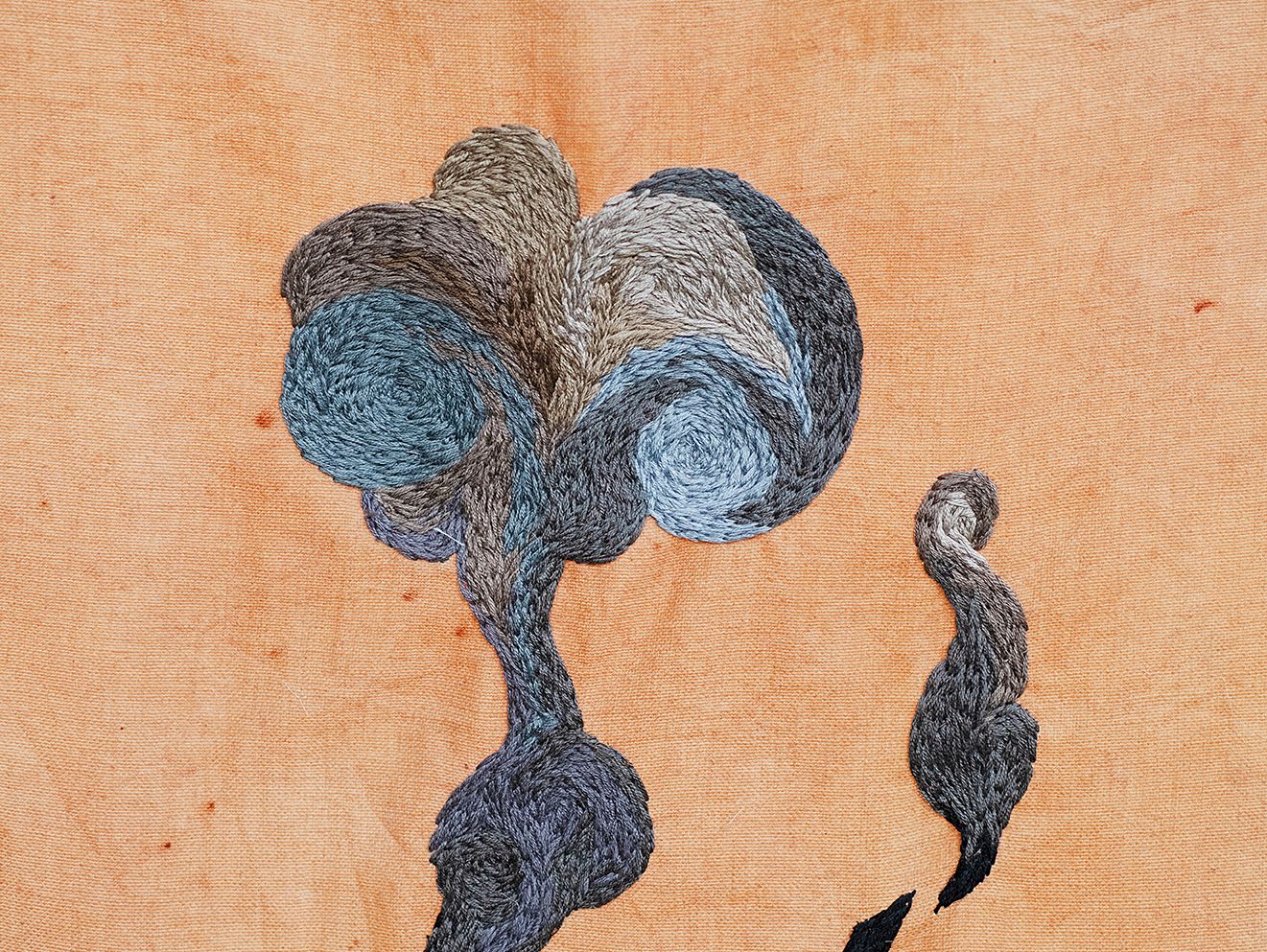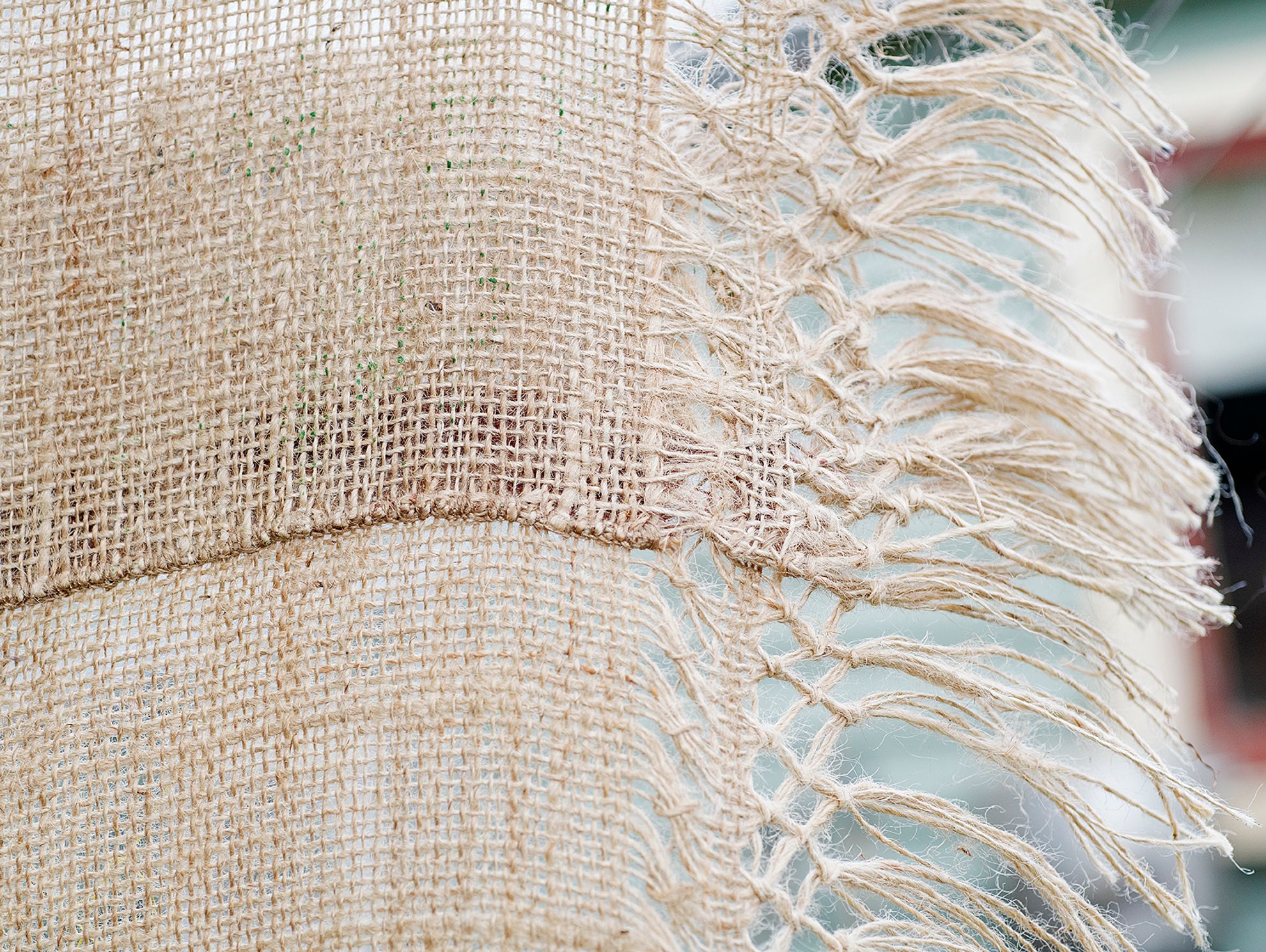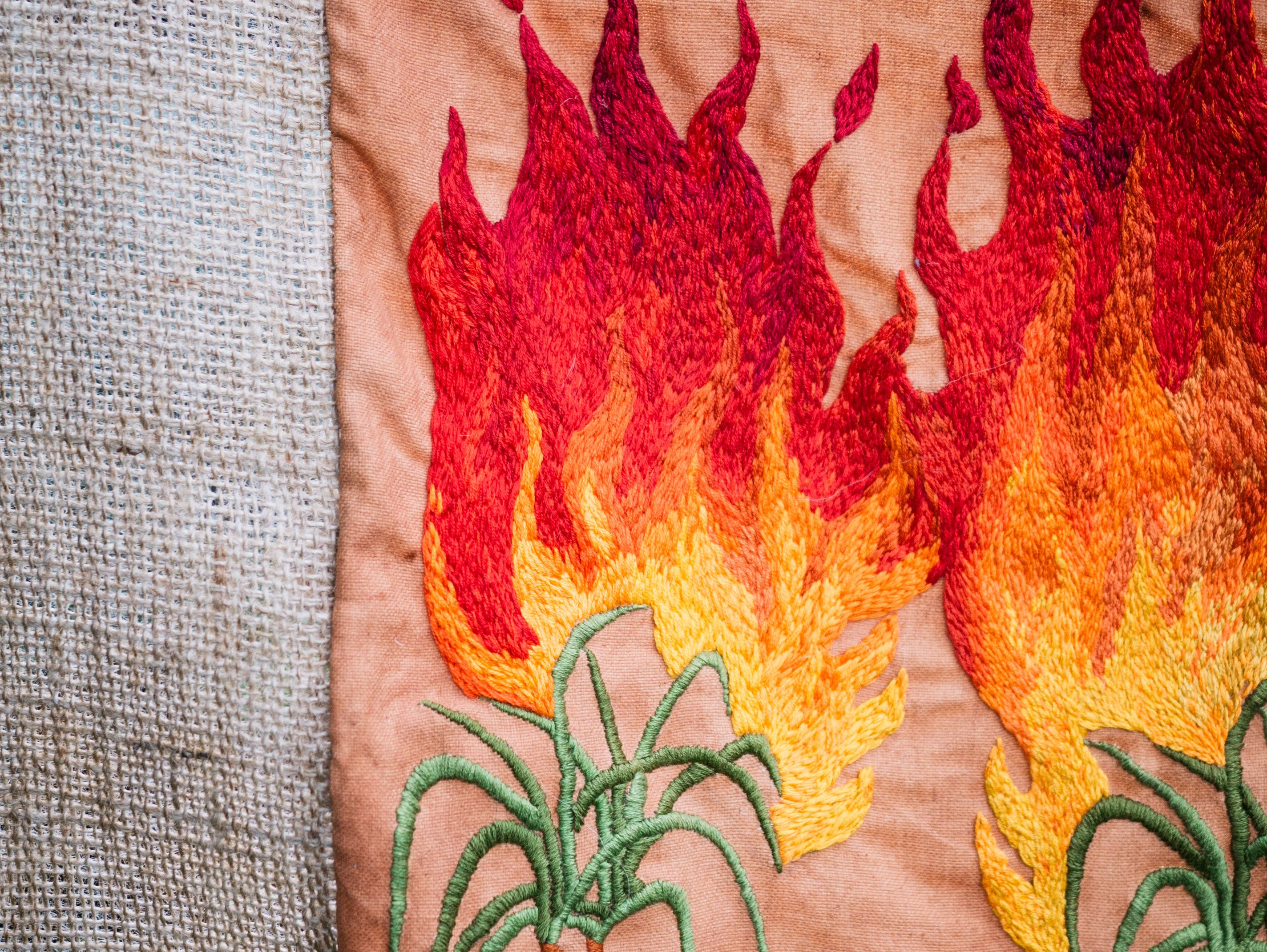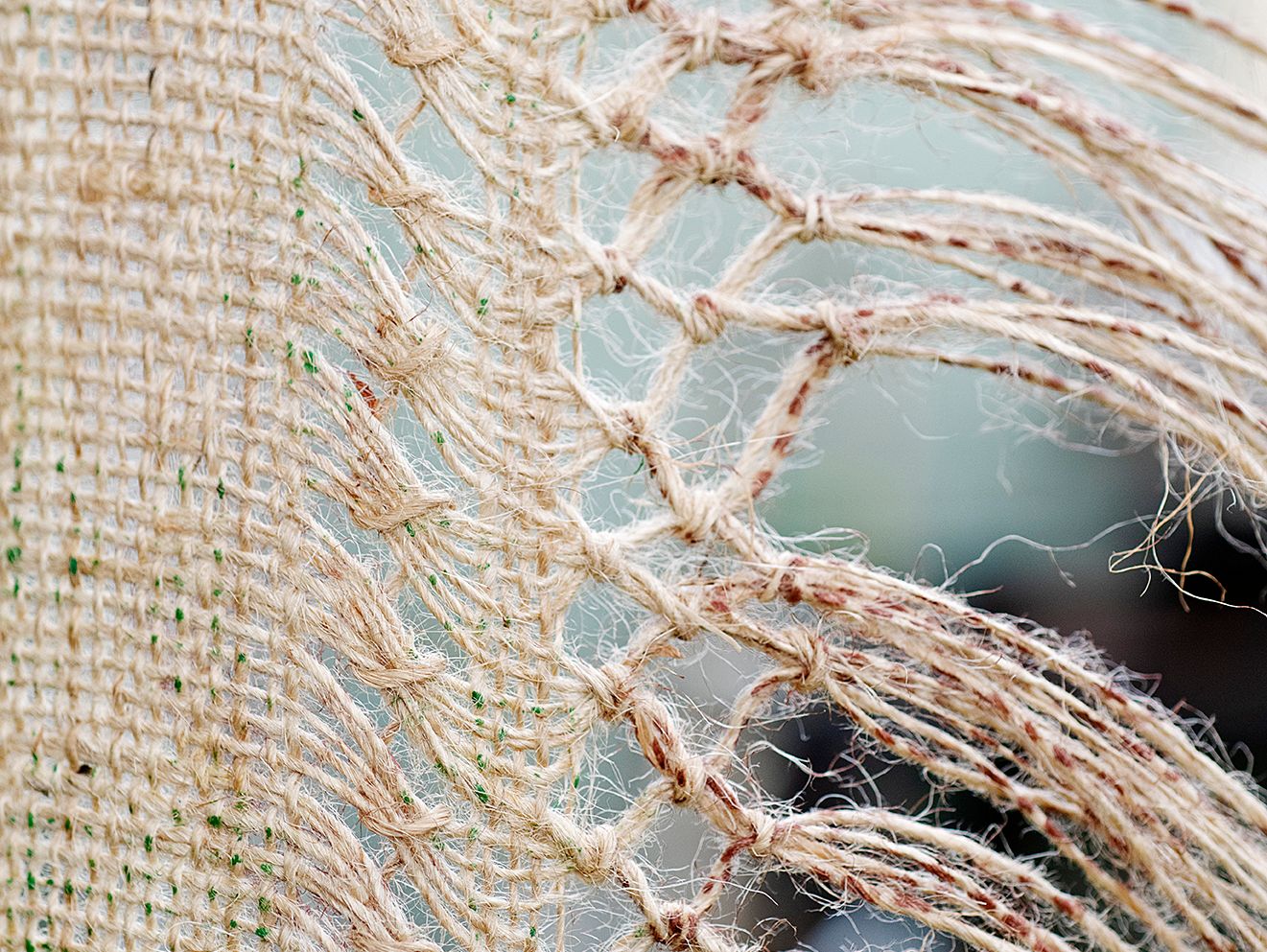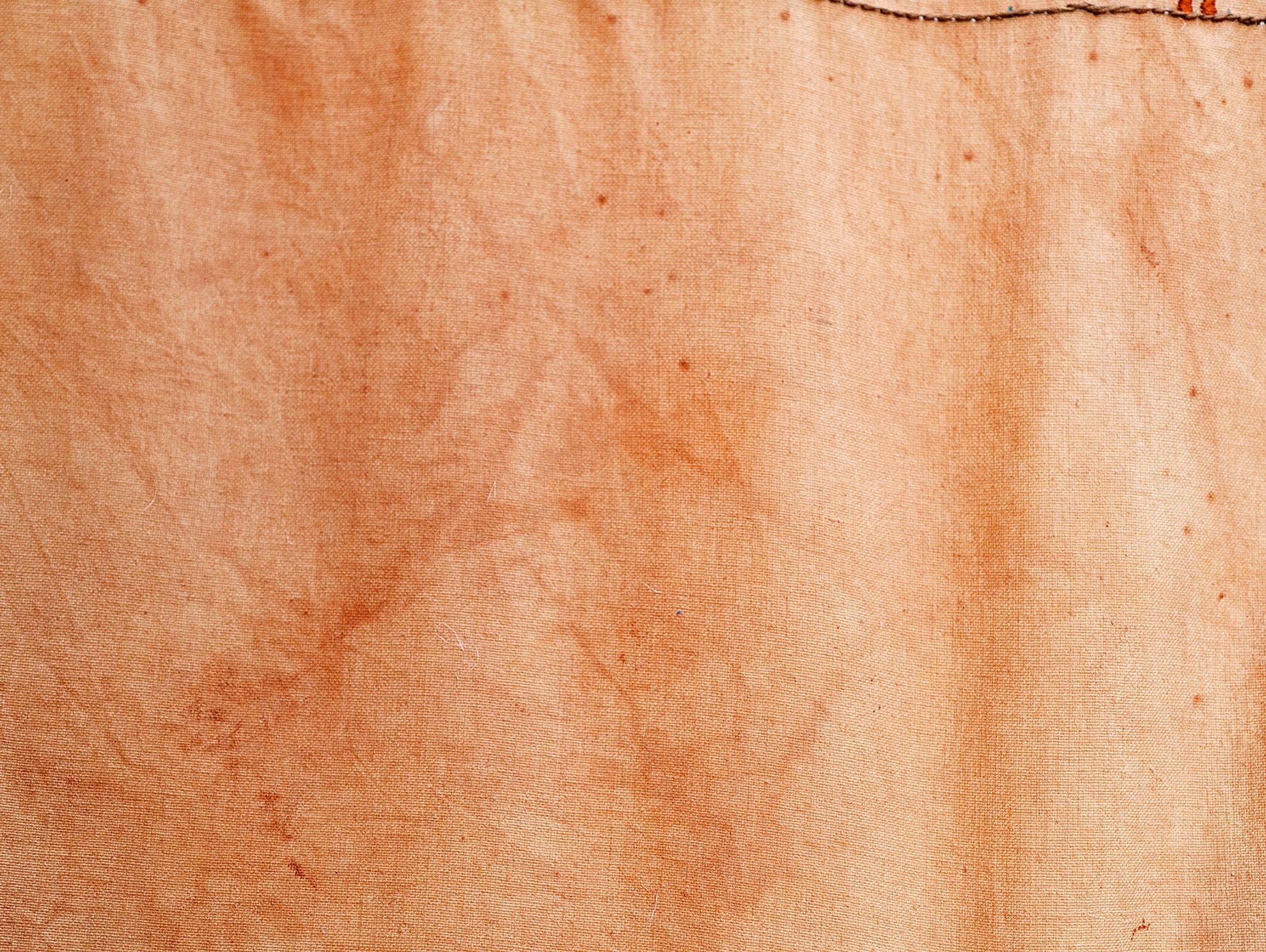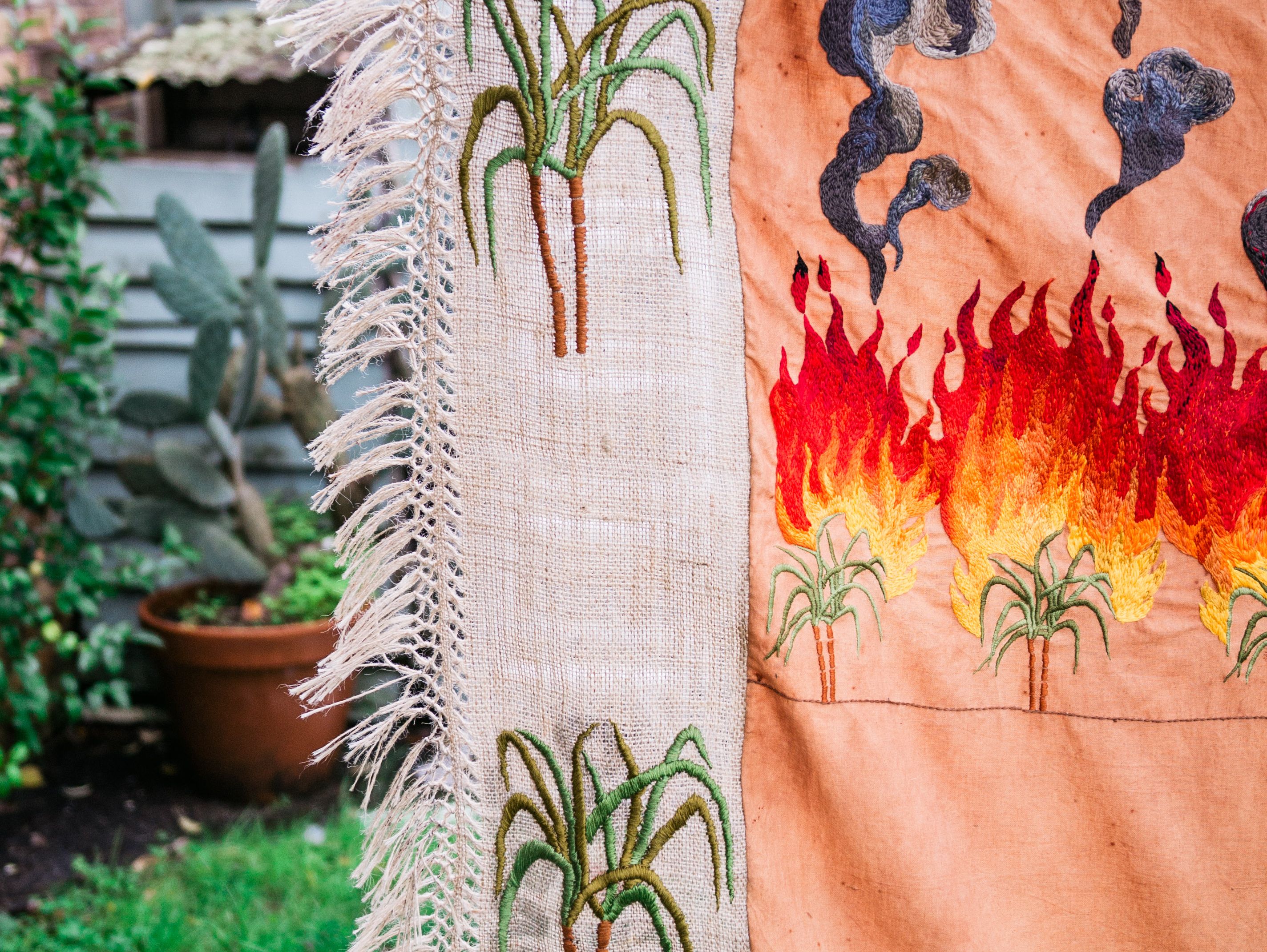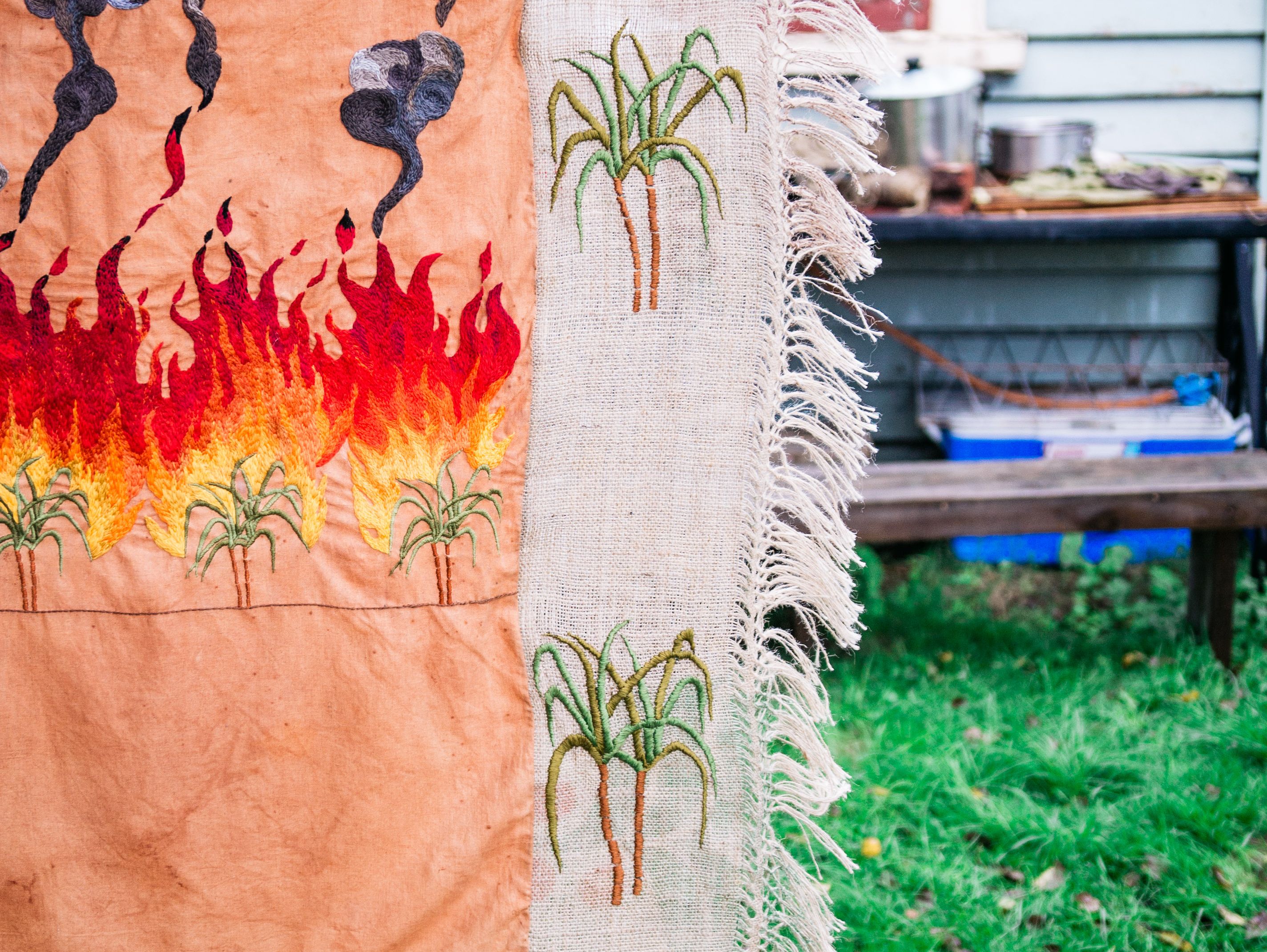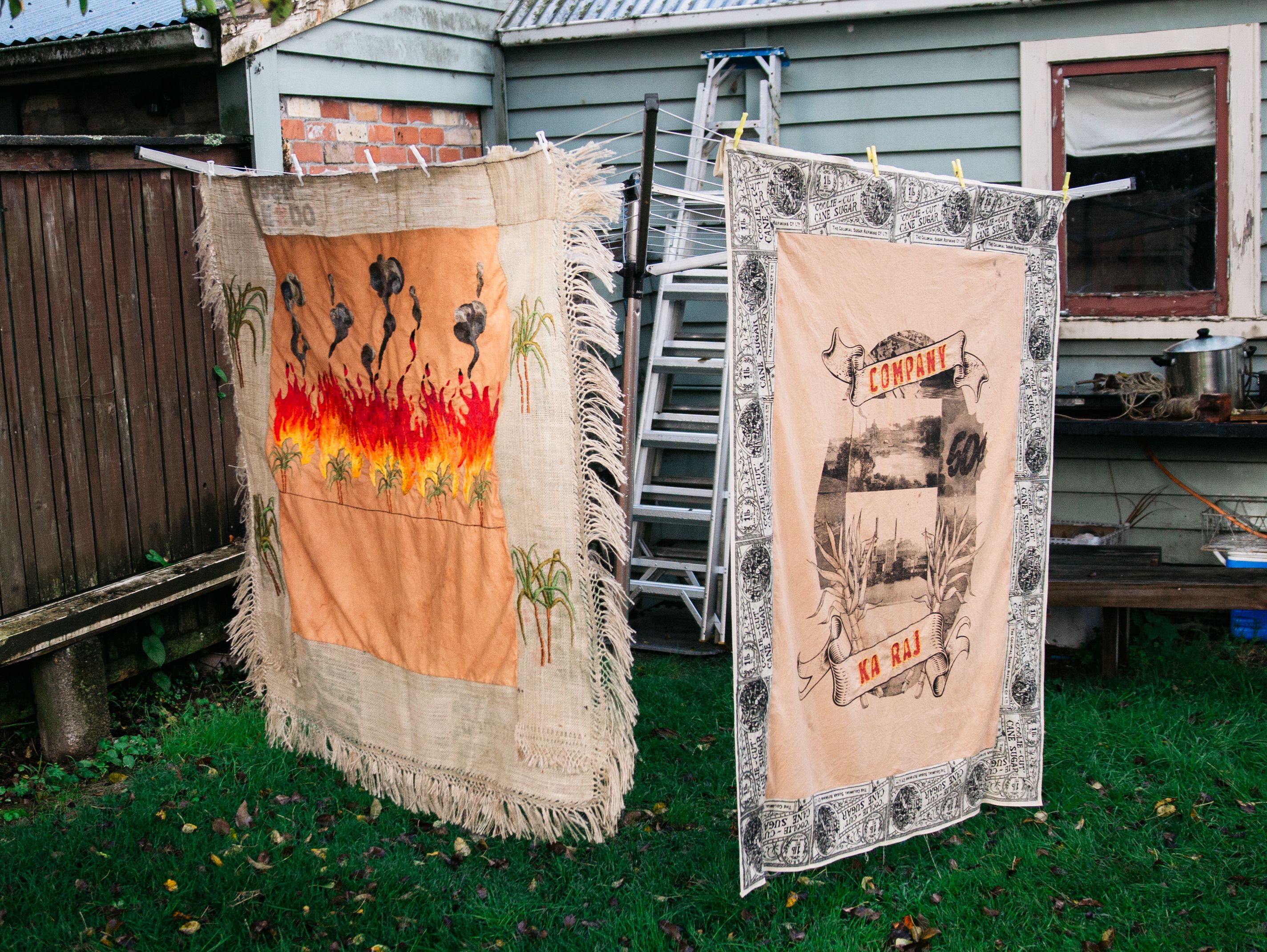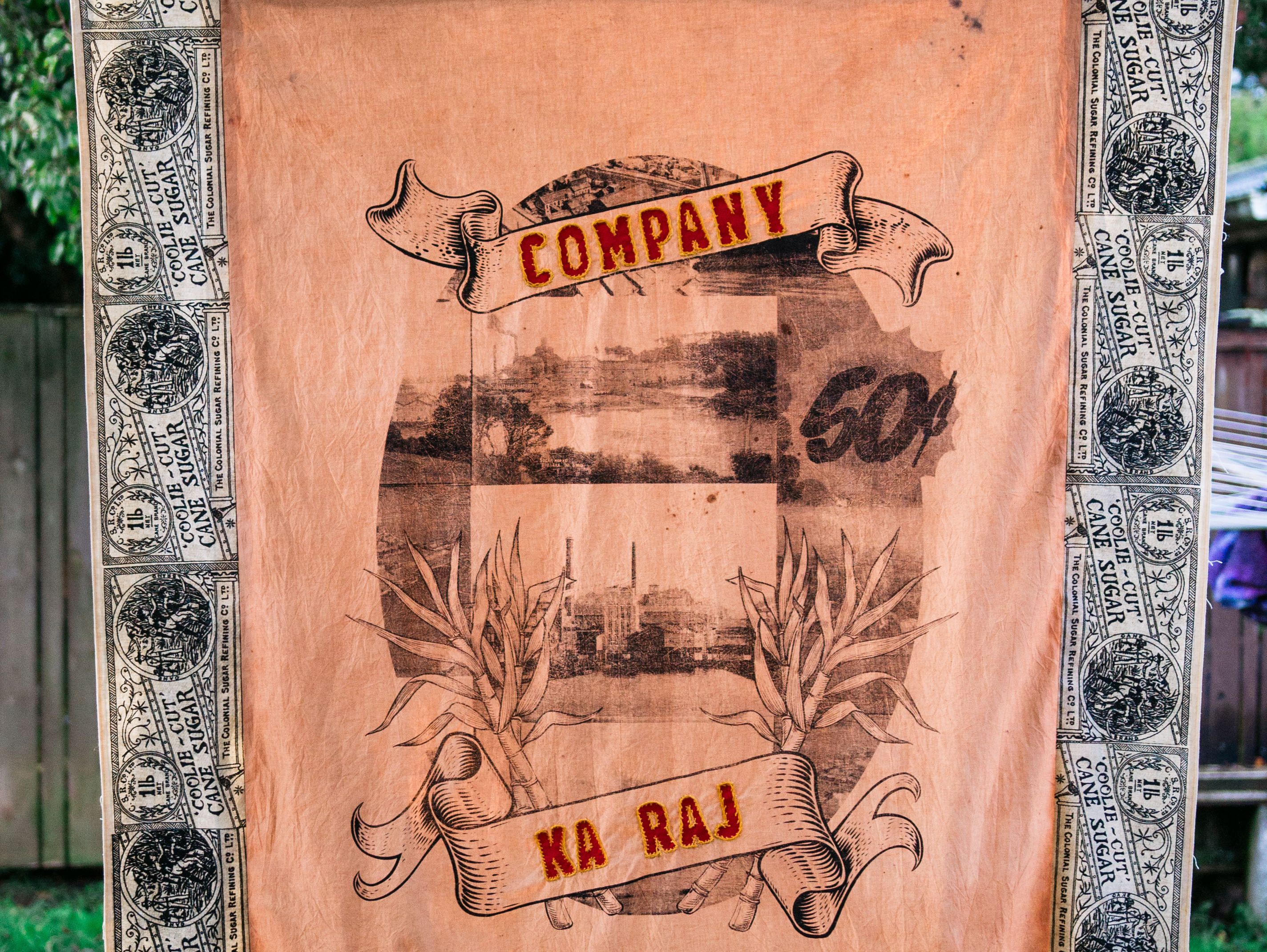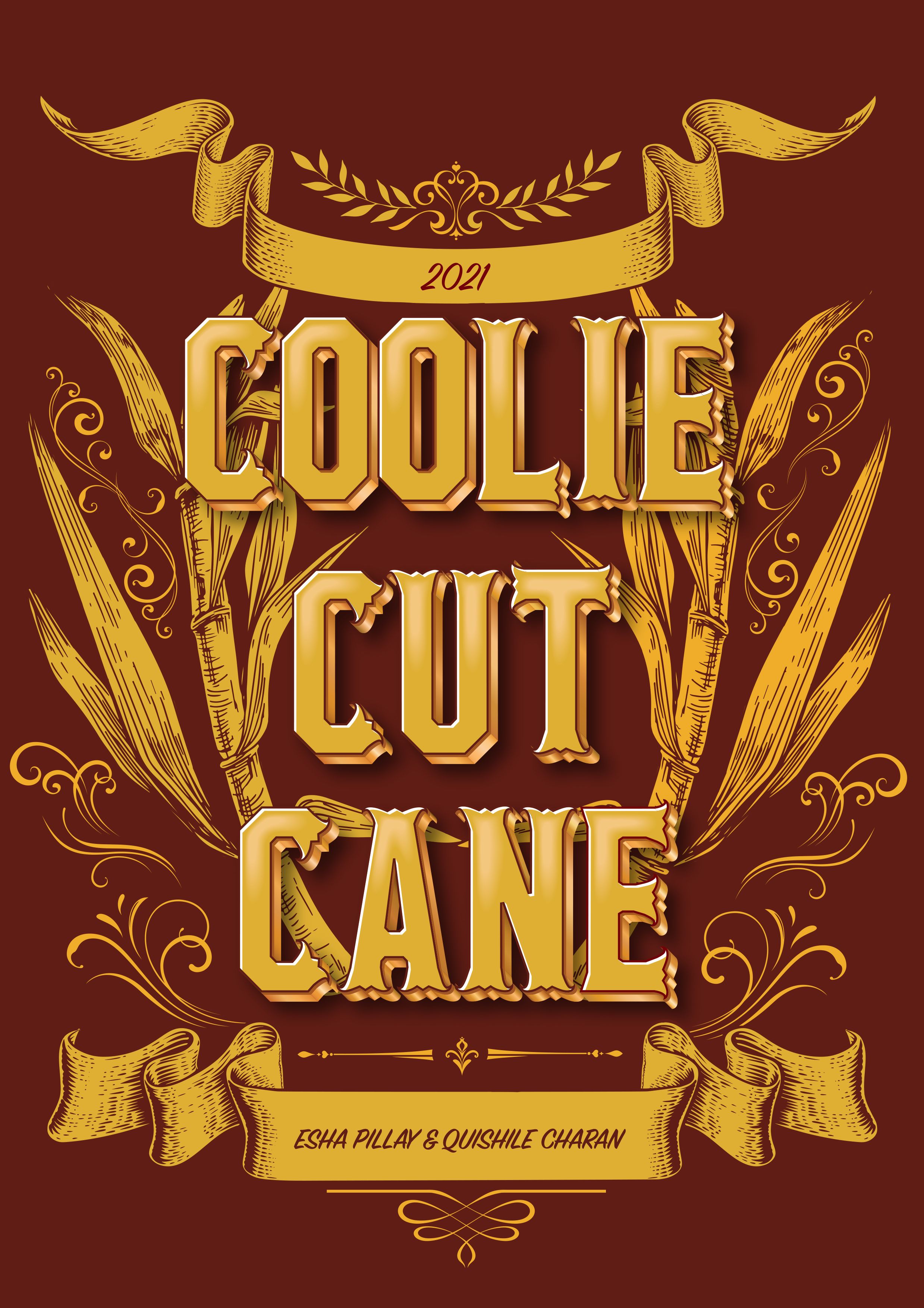
Sugar as Heritage:
But whose heritage?

fig 1
Quishile: For as long as Girmit history in Fiji has been written, we have only ever been offered the “shoots” of this history, rather than the “root” of colonial sugar in the South Pacifc and its whakapapa2. This complicated and devastating history is linked to many Indigenous communities that were and continue to be displaced, their lands stolen, and the violence these communities faced and continue to face so that sugar companies could flourish. The companies in question: The Colonial Sugar Refinery (CSR) Company in so-called Australia, and Chelsea Sugar in the settler-state of New Zealand. Our Girmitiyas ancestors’ subjugation under indentured labour is forever bound to the histories across Te-Moana-nui-a-Kiwa, Samundar, and Oceania. It is important that we have the ability as descendents to unpack and understand how sugar’s violent history is interwoven into the many lives and histories of other colonised and Indigenous communities.
Esha: I once met a couple from the Caribbean. They were in their 50s, the man was from Trinidad and the woman was from Guyana. They asked me about my background and I said I am from Fiji. They smiled and nodded and the man went on to say, “we are all the same people. Fiji, Guyana, Trinidad. all sugarcane people.” I have understood my “heritage” as coming from indentured labourers, being from Fiji, and carrying an identity that sounds interesting but is not really understood in depth or in detail. But is sugar my heritage too?
Being based in the United States for most of my life, the impact of major sugar industries that are directly connected to my so-called heritage seem far off from my everyday reality. The stories of sugar for my family living in Fiji would be different from mine. I believe that the labour of my ancestors and my family members who work on sugarcane farms today is a direct reminder of Girmit in the Pacific. There also is the constant reminder of racial hierarchies “developed through economics”3 when white Australians and New Zealanders are walking around town, eating at local restaurants and vacationing in paradise. These parts of a sugar heritage—the division between labourers and white settlers—are quite visible.
It’s a fact that both Australia and New Zealand are genocidal settler-colonial states. There is a huge investment in maintaining a not-as-bad-as-the-US image on the global stage, while conveniently not confronting the genocidal and generational violence against various Aboriginal, Torres Strait Islander, Māori, and South Sea Islander communities and peoples. Colonisation of different Indigenous communities throughout the Pacific is not separate from the indentured labour histories of Girmitiyas in Fiji. It’s all interconnected through the way that the colonial agenda—and white supremacy—constantly develops and rebrands itself to sustain its power.
When I think about white people’s heritage, I think about colonialism, domination, and brutality. That is their legacy. New Zealand’s regional reputation as a more tolerable and welcoming country in comparison to Australia is directly connected to the state’s early colonial imagination of being “nice.” It was another calculated move for the New Zealand settler state to claim European buildings and artifacts as heritage.4 By connecting the heritage of European settlers to tourism, it lessened their direct role as colonisers on the whenua, the land, as if Europeans had always belonged in New Zealand. And by forcing heritage to become an industry, the historical violence of the sugar industry in the Pacific was masked.
The aim of this essay is to expose how companies like Chelsea Sugar and the sugar industry at large formed out of violence in the South Pacific and the fact that today their websites welcome you with brownie and banana cake recipes. How can you make labour exploitation and colonial violence so sweet and innocent? How can you think that we would forget?
Sugar Plantations:
How far does the Empire travel?
Esha: Before we get into the settler states of Australia and New Zealand, I want readers to understand just how big the Sugar Empire is and how long it has been operating for. That is, how Britain and other European colonial powers turned something so foreign to them as sugar into global labour exploitation for centuries. It’s disturbing to fully connect all the dots and to understand that while enslaved and indentured communities were facing extreme working conditions, violence, displacement, and death, Europeans were in the process of building sugar and sweetness as part of their so-called modern culture. They were becoming fancy.
I believe this particular history around sugar is not made accessible on purpose, even though it’s something found in the food we eat everyday. I can’t map how far sugar has travelled in depth, but the resources in the footnotes will be a good starting-point for anyone who wants to dive deeper into this major part of European colonialism, and how it turned sugar into a never-ending industry.
Sugar as we know it today was originally domesticated around 8000 B.C.E. in New Guinea by Papuans and other Indigenous communities in the South Pacific. After spreading to different islands in the South Pacific5 and Southeast Asia, it reached locations in China, the Indian subcontinent, and western Asia (the Middle East). It was then in the 11th century6 that sugar finally arrived in England, brought through soldiers who were returning back from Jerusalem during the Crusades.7
Sugar plantations were a strategic economic move based on racial hierarchies. While sugar was still limited to monarchs and aristocrats in England in the 15th century, Portuguese colonisers were working to secure and monopolise on trade routes8. Portuguese sugar plantations were first established on islands in the Atlantic9—Azores, Madeira, Cape Verde—and then moved further south to São Tomé and Principe10, and then further south than that, setting up colonies on the African continent in the countries of Angola and Mozambique. During this time the Spanish also began to test sugar plantations in the Canary Islands11. The sugar mills on the Canary Islands were first built and run by its Indigenous community, the Guanches12. Both the Portuguese and Spanish continued to use enslaved people from their colonies in African countries as the main labouring population of these sugar plantations.
Due to deforestation, in 1493 coloniser Christopher Columbus13 took sugarcane from the Canary Islands to cultivate it in Hispañola—present-day Haiti and the Dominican Republic in the Caribbean. Soon after, sugarcane from the Portuguese island colony of Madeira was also transported to coastal regions in Brazil in South America. Both the sugarcane and enslaved African people from these previous sugar colonies were brought to what these genocidal colonisers called the “New World”. By 1550, around 3000 sugar mills had been established in the region.

fig 2
The success of the Brazilian sugar industry in the 16th century demonstrated to the British, Dutch, Danish, and French that investing in sugar plantations14 would be profitable for them. This led colonial powers to invest in other colonies across Central and South America and the Caribbean Islands, eventually making their way to the South Pacific. The labour of enslaved people from African countries, from previous colonies in the Atlantic, and of Indigenous communities from the Americas, became insufficient—especially as both Indigenous communities from the Americas and the African continent had high death rates—and the Triangular Trade15 began to develop. The Triangular Trade named the invasion of Europeans into the African continent with goods to buy people, and the subsequent transporting of enslaved people, mainly from regions in West Africa and West Central Africa, to the plantation colonies in the Americas16. The goods produced through the labour, bodies, and deaths of enslaved African people and communities were then sent back to Europe.
The Transatlantic Slave Trade, or chattel slavery, displaced around 10-15 million people from the African continent, but these numbers are just an estimate that doesn’t account for all the people who were kidnapped, enslaved, and killed, and those who died (at least 2 million) during the Middle Passage.18 The trade hugely benefited the British Empire and gave them the financial wealth and opportunity to establish their colonising projects in North America. Around 40 percent of the total number of enslaved people from African countries were sent over to Brazil (10 times more compared to the US19), but the plantation model used in South America and the Caribbean Islands would set the stage for Britain’s monopoly over North America, especially in the 17th and 18th centuries.
“Slavery made sugar cheaper, and the cheaper it grew the more central it became to the British diet.”20 It wasn’t just the British diet but Britain’s economy and development that relied on the profits and investments of different goods that were produced through the enslavement, labour, and deaths of millions of people and communities from the African continent, forced into the Tranatlantic Slave Trade. The long-lasting effects of chattel slavery and forced labour in North, South, and Central America and the Caribbean Islands signaled to genocidal European colonisers and settlers in Australia that even “Queensland could not possibly be developed to its true potential without the benefit of cheap, hopefully even free, Black labour.”21

fig 3
Australia’s Opportunity:
Sugarcane and blackbirding
Esha: Through stealing land, commiting genocide, enforcing displacement, spreading diseases, forcing conversions, and stealing children23 away from their families and communities, the British Empire and the colonising state of Australia have contributed to the intergenerational traumas and violence still impacting Aborginal and Torres Strait Islander communities and people today. Yet, white Australians, as well as recent immigrant and settler communities, would rather not confront the ongoing anti-Indigeneity and anti-Blackness that Australia is built on. Or how this history is also connected to the Black Lives Matter movement24 that is happening in Australia though constantly sidelined as US racial politics.
Aboriginal and Torres Strait Islander communities and people make up around 27 to 30% of the population in prisons, while being under 3% of the national population. In addition, women from these communities make up 34% of the female25 prison population and are “jailed at rates higher than that of both non- Indigenous women and non-Indigenous men.”26 This reality is Australia’s legacy.27
The settler state of Australia cannot be excused from the significant part of its legacy of genocide and violence that was directly dependent on the wealth accumulated from the Transatlantic Slave Trade. Not only did Australian settlers begin their colonising missions with the profits that they made from dehumanising and displacing millions of people and communities from the African continent, they also gained wealth in the form of compensation when the Slavery Abolition Act in 1833 was passed. This meant that after chattel slavery was supposedly abolished, the British parliament in 1835 gave 20 million pounds (around 300 billion today) to former slave owners for “loss of income”.28 Many major companies, businesses, banks, universities, cities, and “founding” figures across Australia were only made possible because of this so-called wealth.
Prior to British coloniser James Cook, other Europeans including the Dutch, French, and Spanish had made their way to what later on became “Australia”. But soon after Cook’s invasion in 1770 the stakes became higher for the British Empire to re-establish itself. The British were desperate because after the war with the US, their American colonies were no longer accessible, and they needed a different settlement to ship over their British convicts30 because their prisons were becoming overcrowded. This was known as a “penal”31 colony. From 1788 to 1868 Britain sent around 164,00032 convicts to Australia, with their early penal colonies being marked at so-called Botany Bay and Port Jackson in the capital city of Sydney in New South Wales.
The Slavery Abolition Act in 1833 and the US civil war that went on from 1861 to 1865 (also based on whether chattel slavery should continue) played a critical role in building Australia’s economies. On cotton plantations in the US South, from 1801 to 1862, “cotton picked daily by an enslaved person increased 400 percent.”33 This skyrocketed the US economy on a global stage and none of it would have been possible without the brutality and inhumane conditions that enslaved African and African-American communities were subjected to.
Colonisers anticipated that their biggest industries in the US were soon coming to an end, because if chattel slavery could no longer continue, how else would they make money? This signaled to British colonisers that they needed to quickly set up a tropical plantation economy somewhere else. An example is The Queensland Manchester Cotton Company, which was established in Australia only a couple of months after the US civil war began. Robert, Matthew, and David Muir—the brothers who started the company—were cotton plantation owners and slave owners from Louisiana.34 The plantation model from chattel slavery in the US served as a foundation for what colonisers were hoping for in Australia’s economy, because they saw how successful it made them—the oppressors, Britain, Europeans, the white race. However, the cotton industry did not meet their profit expectations and was failing at that time. Sugar became the Empire’s next shot in securing dominance in the region.
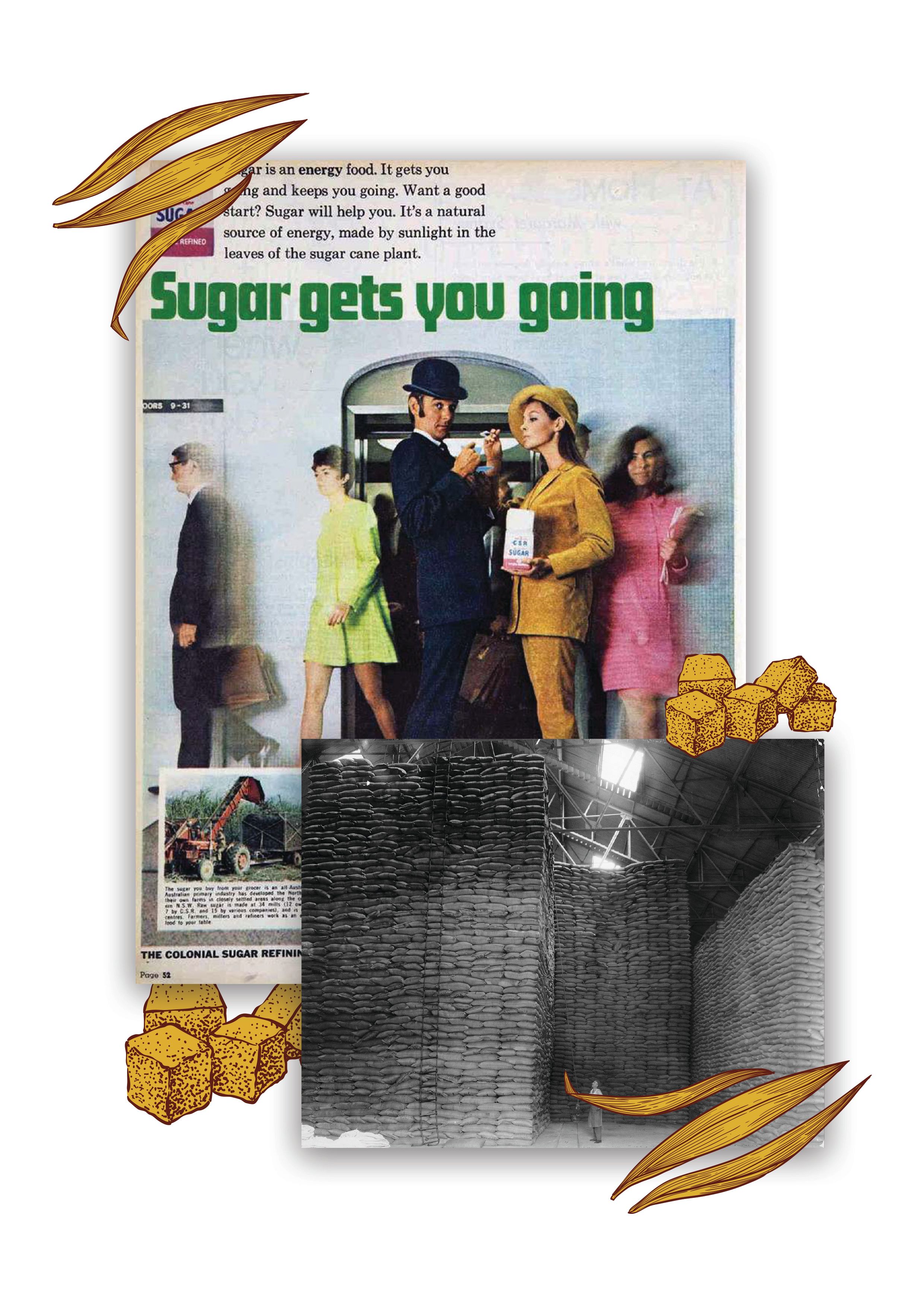
fig 4
The company that had the most widespread success with sugar slavery and exploitation in Australia—and later on in New Zealand and Fiji—was The Colonial Sugar Refinery Company, or CSR Sugar (formerly known as the Australasian Sugar Company).
Founded by Edward Knox in Sydney in 1855, CSR sugar dominated the sugar industry because the company made money from all aspects of sugar production, such as “borrowing funds, in purchasing supplies and indentured labour, in training indentured labour, through the gang system of organizing labour, in supervision of indentured labour, in transport indivisibilities, in milling indivisibilities, and in marketing sugar”. 36 The company’s success and foundation relied on the violence of blackbirding because CSR Sugar knew that to maintain profits, the wages for the labourers would have to be extremely low.
Blackbirding can be described as slavery, sugar slavery, kidnapping, and forced labour of different Indigenous communities and people from the Pacific Islands.37 It was yet another opportunity for the British Empire to continue the exploitation of Indigenous communities so their colonies could gain control over stolen land and establish a powerful economy to create Australia.
Labourers were expected to clear the land, maintain the land, and cut cane38 for low wages, but the machines at the sugar mills and the final product had to be of high quality. This essentially sought to make the labour of South Sea Islanders invisible; yet, today sugar is Australia’s second-largest export crop. Kidnapping, forced displacement and labour exploitation through blackbirding is how CSR Sugar became so rich, but the story of the company’s start and success is told through the lens of Edward Knox’s (and later on his son, Edward William Knox) “risk-taking” business mindset—he took a chance and the sugar industry magically flourished.
When you enter CSR’s website today, you see nauseating pastel colours, how-to video recipes demonstrated by pale-skinned hands, and the company’s proud branding as “Australia’s Premium Sugar”. You might not initially associate the sugary treats you see on their website with how it all began: sugar slavery. This industry was built on slavery, brutality, and exploitation. It not only impacted the labourers whose bodies were used to build a violent state but remains an industry that actively tries to deny communities today of their ancestors’ histories and legacy.
Are white Australians not ashamed of their colonising ancestors? Or is it easier to believe that they have no direct connection to them and we live in some post-racial society where talks of multiculturalism will save us? This is the power of whiteness, which “remain[s] unmarked and unmasked”39 for generations because it is able to camouflage itself very well. Whiteness and proximity to whiteness dominates what is normal and all that is right with the world. White supremacy doesn’t allow us to question it, and that’s why you don’t have to think about where the products you consume every day are coming from.
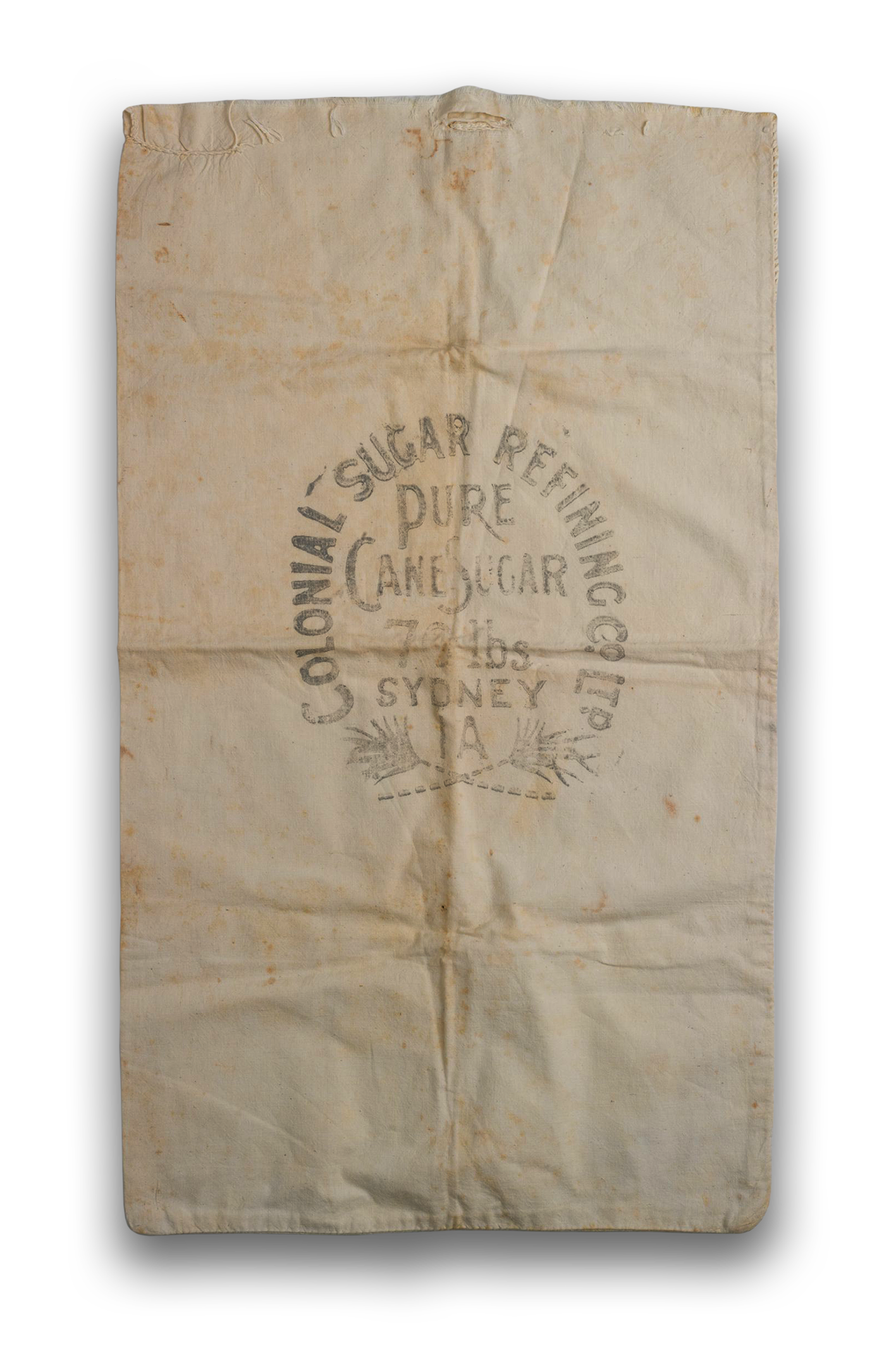
fig 5
South Sea Islanders:
Labour and legacy of ancestors
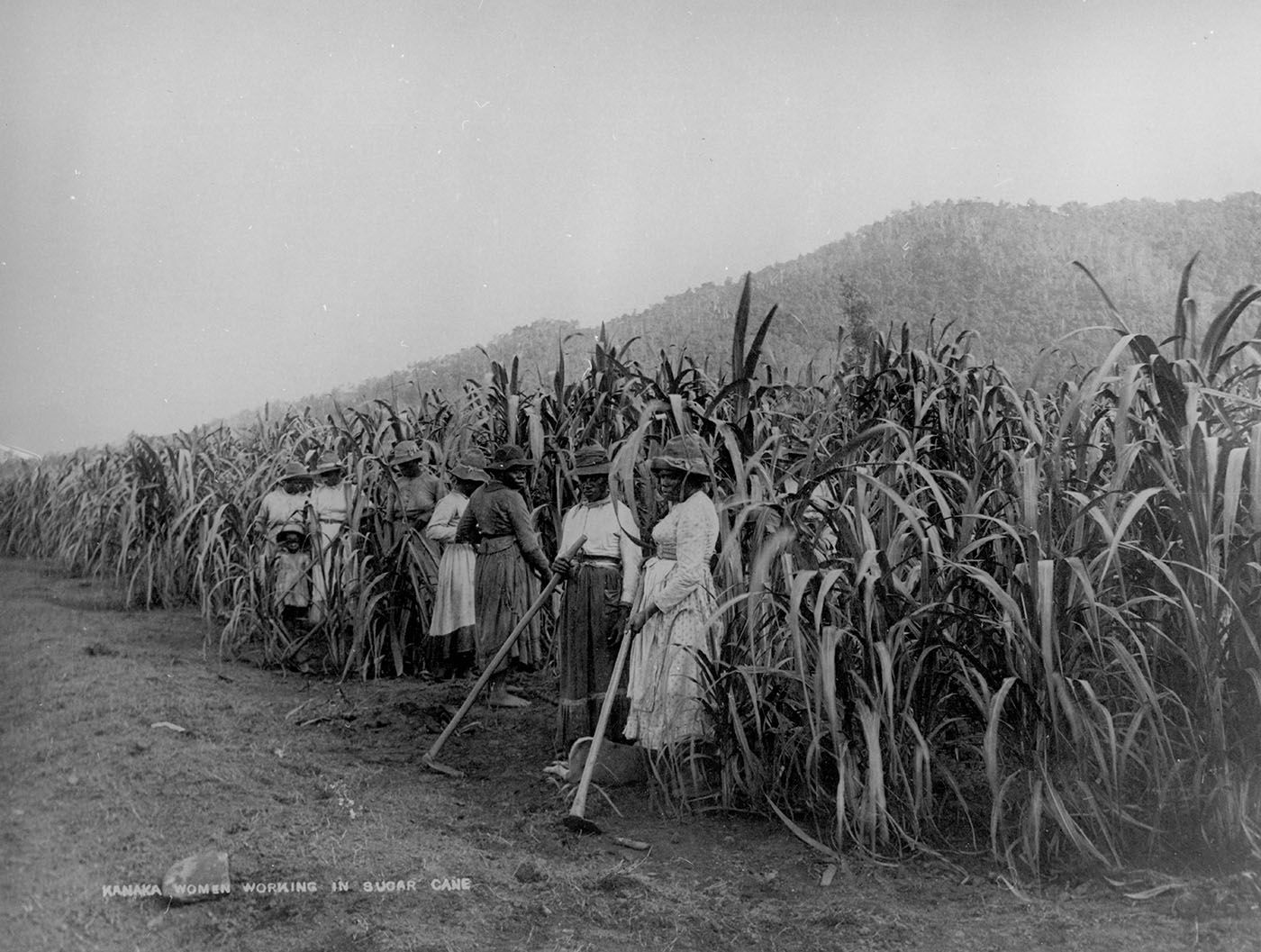
fig 6
Esha: There are multiple histories within South Sea Islander communities living in Australia and in other islands and countries. This essay of course cannot capture all the complex parts of this history. For our collective and this research, allowing histories of Girmit and blackbirding to intersect is important and necessary in understanding the impact of colonial violence that sugar companies and industries have forced onto our ancestors. Our collective also acknowledges that our communities are not homogenous, and this essay’s purpose is to give space and time to understand the histories of various communities across the Pacific.
Blackbirding is often described as a “forgotten history” in Australia’s role in slavery. But it’s not forgotten to South Sea Islander communities, who are the descendents of this history. If there is anyone who has catching up to do, it’s colonisers, and white people, and settlers who should do their part in learning the history around the slave trade in the Pacific.
The violence of blackbirding for Aboriginal and Islander communities spanned across pastoral, maritime42, and sugar industries. On 16 April 1847 colonisers Benjamin Boyd and Captain Kirsopp brought the first 65 labourers via blackbirding to New South Wales on the ship Velocity. The majority of the Islanders were brought from Lifu43 in the Loyalty Islands (now part of New Caledonia) and from Tanna and Aneityum in the New Hebrides (now Vanuatu), with other people coming from surrounding islands. Boyd wanted them to work on his pastoral and whaling operations in the Eden, Riverina, and Monaro regions, where he was already using the forced labour of Aboriginal and Māori people.44
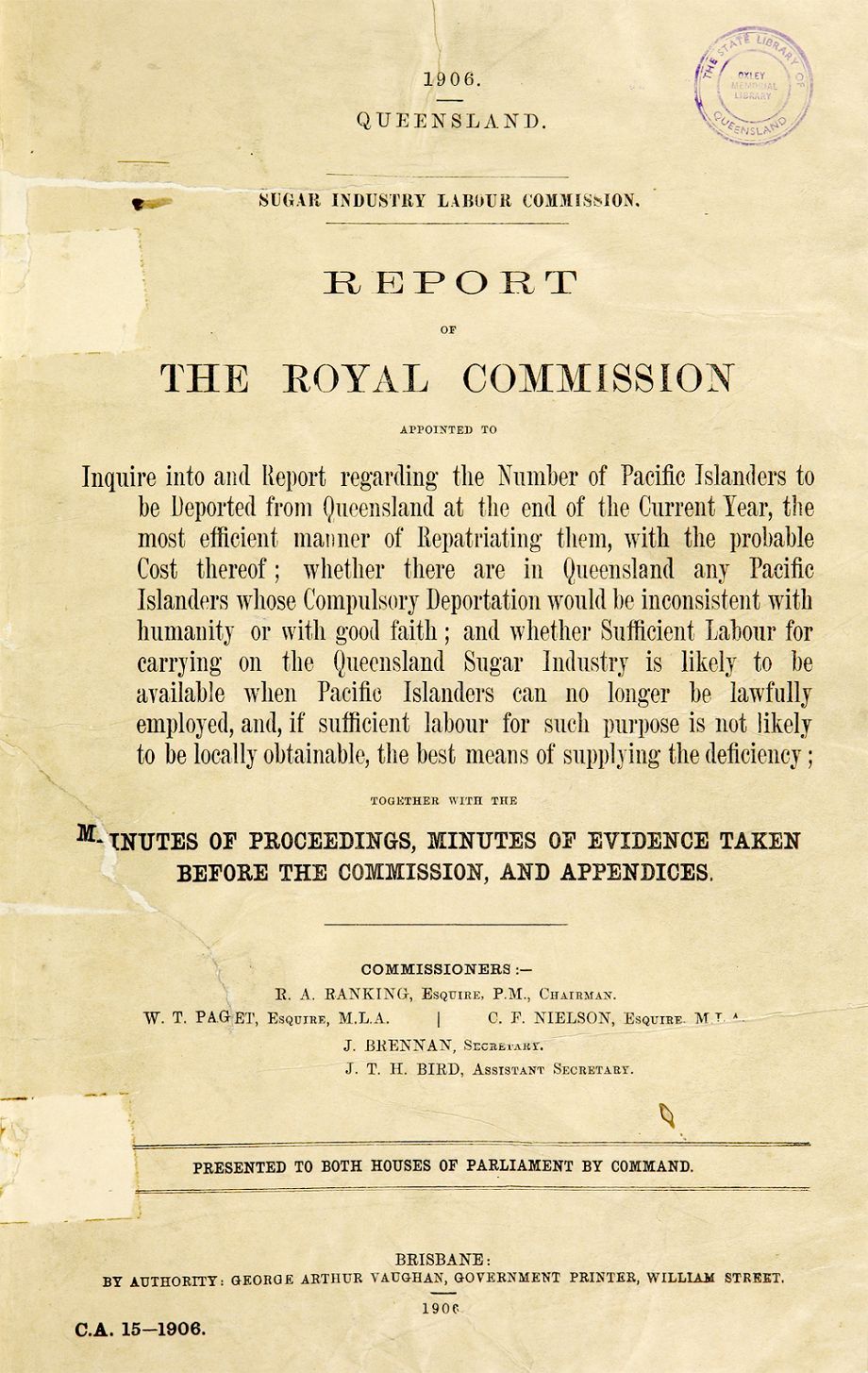
fig 7
In the same year, in September, Boyd again brought 70 South Sea Islander labourers to Sydney,45 and then another group of 57 people (including three women) in October. However, Boyd and Kirsopp’s “experiment” with blackbirding didn’t last too long, due to the brutality and violence South Sea Islander labourers were experiencing, but also because many people were resisting and fighting back. Boyd then took off for California to test his luck in gold mining, but that too failed and soon he ended up in Guadalcanal, which is part of the Solomon Islands. On 15 October 1851, justice was served when Boyd was killed46 by the Indigenous peoples in Guadalcanal.
Even though Boyd’s legacy with blackbirding in New South Wales didn’t go as he had planned, it did serve as a catalyst for the sugar exploitation to come in Queensland. This is the continuing pattern of European colonisers who replicate systems of slavery, forced labour, and exploitation on different lands to ensure that they will stay the dominant force across trade and industries, and a “superior” culture. This is the heritage that they have created for themselves, while the descendants of the communities they oppressed continue to face the consequences of generational violence. Do colonisers ever face the consequences of their legacy? Or will their statues48 continue to be used as heritage sites of praise for genocidal settler-states?
White supremacy is possible when you have a severe imbalance of wealth and power. The sugar industries across Australia would not have been possible without blackbirding violence, labour and exploitation. Even the deaths of people and communities who were forced into blackbirding was profitable for the Empire and the Australian state. The unpaid wages that were rightfully that of the labourers who died was stolen by the Commonwealth, which amounts to around tens of millions of dollars today.49 This is an example of generational and structural violence that is an inconvenient memory for the Empire.

fig 8

fig 8
Queensland and Sugar Slavery:
‘White gold’ exploitation
Esha: Once the colony of Queensland became separated from New South Wales in 1859, colonisers urgently needed to figure out what industry would be able to survive for some time in the region. It was genocidal coloniser Robert Towns who took the lead. Before forcing Islanders into blackbirding, Robert Towns worked with colonisers William Wentworth and Gordon Sandeman to bring Indian and Chinese coolies to Australia as cheap labour, including for work on his pastoral properties in New South Wales and as servants at his mansion at Vaucluse House52 (located in present-day Sydney). Towns then set his eye on expanding the cotton industry in Queensland, once the US civil war halted the export of cotton. He was looking forward to bringing in more Indian and Chinese labourers to work on his cotton plantation in Queensland, but the colonial governments in these countries did not allow for it.53
On August 17, 1863 Robert Towns, through kidnapping and force, brought 67 men from the islands of Vanuatu and New Caledonia on the ship Don Juan to Moretown Bay (in Brisbane). They were taken to the Townsvale cotton plantation in the Logan River region. This is why the city was named Townsville,54 after Robert Towns’s role in the slave trade and the forced displacement of Wulgurukaba and Bindal communities. Towns was not alone—he had the assistance of coloniser and rapist55 Henry Ross Lewin. Through “hunting for labourers, [Lewin] shot men, women and children, burned villages and destroyed crops”56 while he was living in Vanuatu (Tanna Island). Forcing themselves onto lands that they were not welcome on, the colonisers on these different islands had to continuously co-ordinate in order to maintain their control. This was a business at the expense of human lives.
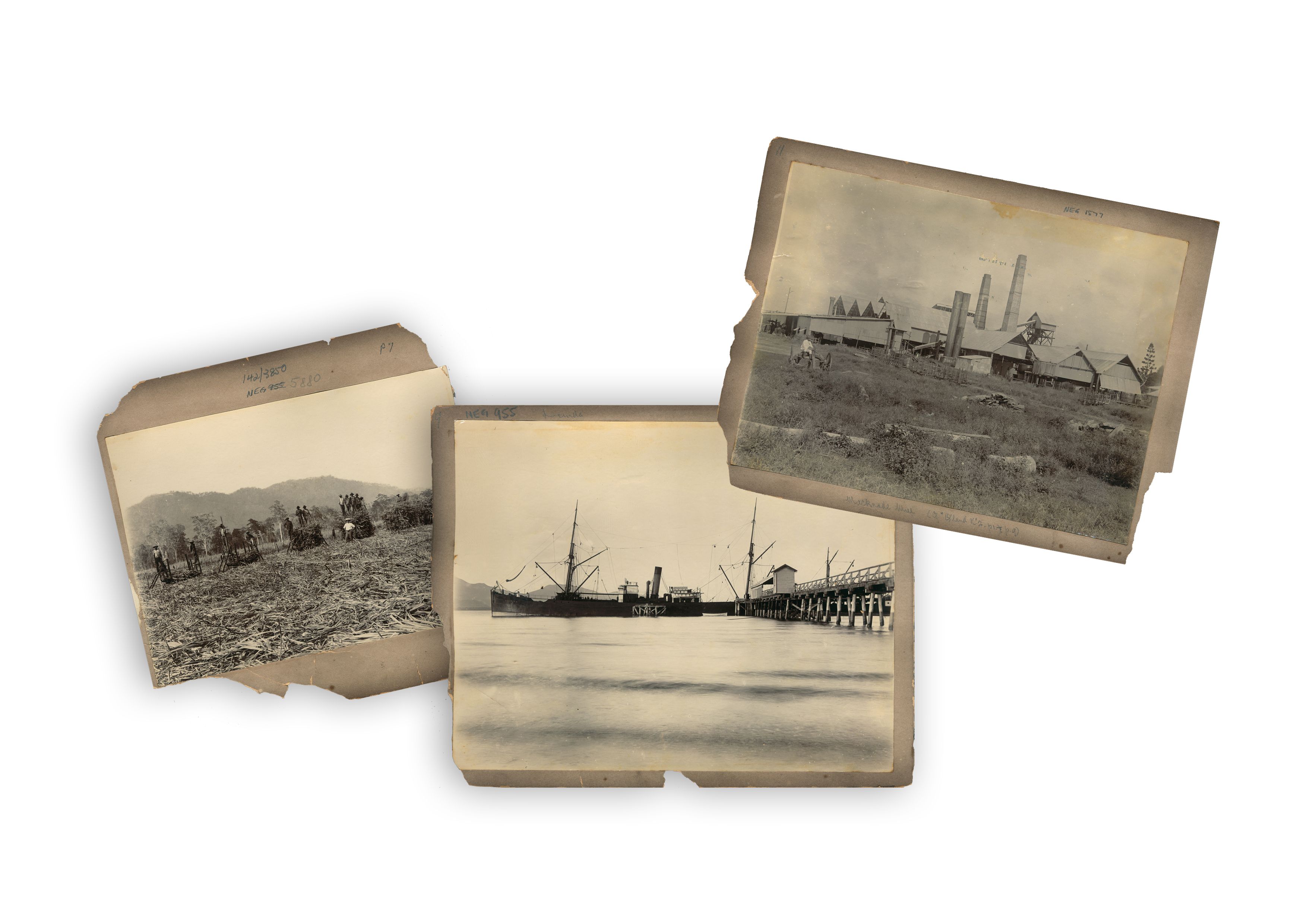
fig 9
Mackay58 is another city formed from blackbirding violence in Queensland, and today this where the biggest population of South Sea Islanders resides. The city’s heritage-site cemetery now has a section for the graves of 160 labourers who were identified by Starrett Vea Vea, the chairman of the Mackay and District Australian South Sea Islander Association and his team from 2016. Identifying the graves was a process of acknowledging and honouring one’s ancestors and the labour, lives, and deaths of all the South Sea Islander communities that built the sugar industries in Queensland and across Australia.
One coloniser who took inspiration from the success of sugar slavery, or “white gold”60, exploitation in the Caribbean and led the sugar industry in Queensland was Louis Hope. On his way to Australia, Louis Hope noted in his diary that he was disappointed that Tahiti was already under French control,61 but nevertheless he knew he could demonstrate his “humanitarian” values when he realised his true potential in setting up sugar plantations in Queensland. Coloniser Louis Hope believed that blackbirding Islanders would “[benefit] not only the colony, but [benefit] themselves, and [benefit] those they leave in the islands”.62
This twisted logic made Hope believe that he was actually doing something good, which served as a legitimating excuse to distinguish blackbirding from slavery, masking this violence as “indentured labour” instead. He believed that because the people and communities who were forced into blackbirding weren’t considered property—whereas in chattel slavery people were property—this form of labour wasn’t as genocidal. Was this some sort of family wisdom for Louis Hope? It sure was. Hope’s uncle, Andrew Wedderburn-Colvile, was the man who “pioneered” the idea of Indian labourers and coolies being sent to British Guiana63 after the Slavery Abolition Act. These are the kinds of connections and links that need to be exposed; the Empire would rather have you forget this ongoing imperialism.
Louis Hope took Benjamin Boyd’s idea of blackbirding Islanders to establish his own sugar plantation, the Ormiston Sugar Mill, in 1863. Hope was proclaimed as the “Father of the Commercial Sugar Industry in Queensland”.64 With the assistance of coloniser John Buhôt, who was a sugarcane plantation owner and slave owner from Barbados, by 1864, 20 acres65 of sugarcane had been planted. The Queensland government soon passed the Sugar and Coffee Regulations Act in the same year, which allowed other colonisers to buy land to grow sugar. This led to the increase of 1,995 acres of cane in 1867 to 28,026 acres of cane in 188166 (from 168 tons to 19,051 tons of sugar). This was sufficient for “domestic consumption”67 for the Queensland economy and also for exporting to colonies in Victoria and New South Wales.
Hope’s success, and legacy, was dependent only on the labourers he brought over to Queensland through blackbirding. This allowed for other colonisers and settlers to invest in the sugar industry, and many were given advice by Hope directly. From 1863 to 1904, around 62,500 Islanders were brought over to Queensland and other parts of Australia via the violence, displacement, and brutality of blackbirding. The labourers came from more than 80 islands, including Vanuatu, Solomon Islands, New Caledonia, Papua New Guinea, Fiji, Kiribati, Tuvalu, Samoa, Gilbert Islands, and New Ireland.
The majority of the people who were forced into blackbirding were men, but there were also smaller groups of women and children as well. Within those main years of the blackbirding trade, it’s estimated that around 15,000 Islanders died. The sugar industries in Australia and the Pacific wouldn’t have been possible without the violence committed against those who they forced into blackbirding, and that of their South Sea Islander descendents for generations. This is a significant foundation to Australia’s genocidal settler-colonial agendas, and explains their power in the region and their real and direct involvement in multiple slave trades.
When speaking about European or British colonialism specifically, there is usually a quick denial by white people as if it’s a horror of the very distant past. Then, there is the excuse that not all white people were slave traders, or that poor white folks were also oppressed and that they have no connection or direct benefit from different slave trades. But, that’s not true, because anti-Indigeneity and anti- Blackness operate globally69 and are woven into every single structure in our societies.
Colonisers who came to establish the Australian state and sugar slavery in the Pacific, such as Thomas Alison Scott (apparently the first person to grow sugar in Australia), Benjamin Boyd, and Louis Hope, were all either the sons and/or grandsons70 of slave traders from the Tranatlantic Slave Trade, or Caribbean plantation owners, or both. This is their heritage. And the wealth accumulated from the legacy of this violence in various regions around the world would ultimately benefit and privilege white people in many parts of the world.
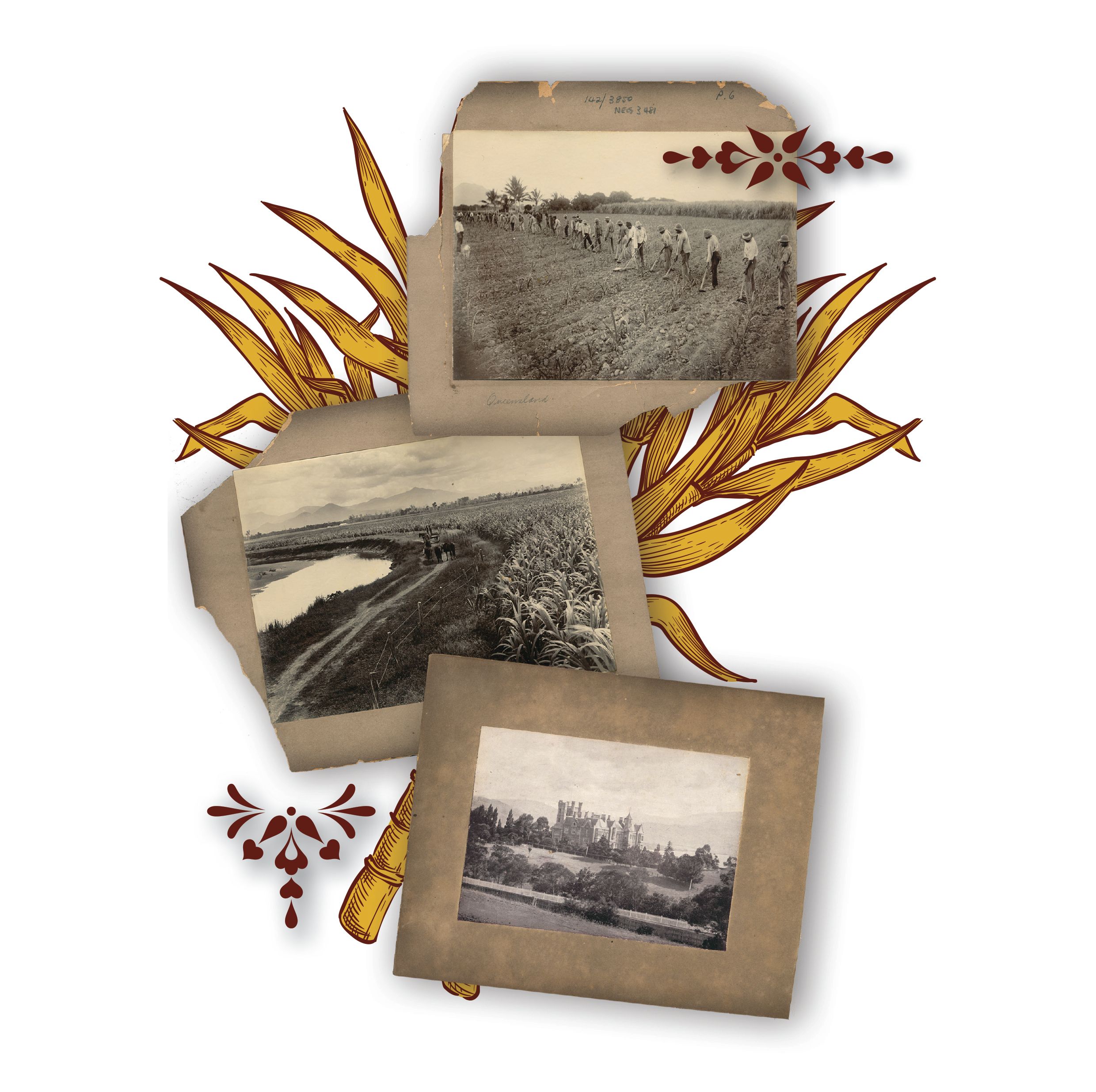
fig 10
The Mythology of Gordon and Corporate Colonisation
Quishile: Of the many colonial myths written as Fijian history, Sir Arthur Gordon’s native policy had the biggest impact, forever changing the social landscape of Fiji. Gordon, who was Fiji’s Governor General from 1874 to 1880, implemented the Native Policy in 1875, which earned him the reputation of saving iTaukei from the grips of white settlers who sought the “alienation” of Indigenous lands and who were trying to build Fiji into a settler-state. Fiji was believed to have dodged a bullet compared to other Indigenous communities as “[t]he imperial impact was not a story of ruthless exploitation and dispossession of an indigenous people. It would have been had the white settlers had their way.”72
This narrative has survived as a way of undermining Fiji’s complicated and complex colonisation and allowing different settler-states such as so-called Australia and New Zealand to distance themselves from being accountable to their many violences across the South Pacific that still impact communities, lands, and seas today. Gordon’s native policy set about a framework of indirect rule that became what we now call corporate colonialism. This section of writing will be an attempt to shatter Gordon’s legacy of white saviorism and position him and his governmentality within corporate colonialism.
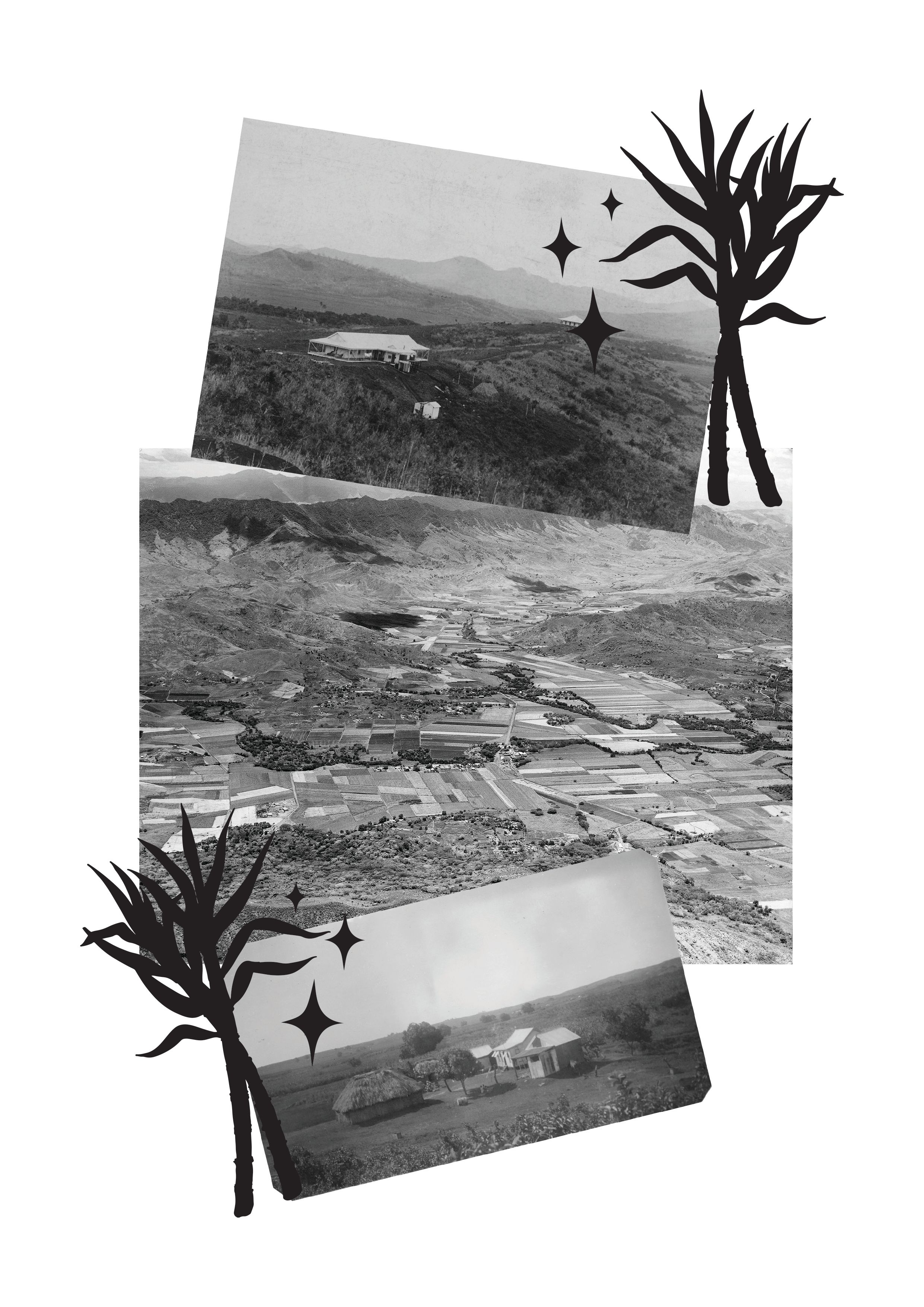
fig 11
Fiji is in the midst of cyclone season, seeing a new record succession of cyclones, with Tropical Cyclone (TC) Yasa (December 2020), TC Ana (January 2021)73, and more predicted to hit Fiji soon. These events are of no coincidence and all have a root cause: the exploitation of land and oceans through policy and law that has enabled generations of colonial capitalist agendas in Fiji. Another complicated issue with Gordon’s native policy is that of the ethnic divides it laid out between iTaukei and Girmitiyas, placing both communities in opposition whilst conveniently concealing European colonisation in the background to these problems. I do not believe I can cover the full complexity of Gordon’s impact on Fiji in this one essay—maybe that task will take a lifetime—but this writing will serve as a beginning to unpacking this history further.
At the time of Gordon being sent to Fiji by the Crown, the colony was in decline. His job was to drag Fiji out of its economic despair. Unlike many of the white settlers in Fiji, Gordon valued a particular type of enterprise that did not favour the individual settler mentality—his objectives and those of the Crown did not morally align with the growing white settler population in Fiji at the time. Prior to the cession of Fiji to the British Empire, there was an influx of “misfits and brutes from Europe, America and other British colonies sporadically washed up in Fiji”.74 These “misfit” white settlers were predominantly coming from New Zealand and Australia, but at this time, white settlers from these settler nation-states had a bad reputation and were seen morally different to that of Christian missionaries and the Crown.
In New Zealand within the period of the early 19th century, missionaries had envisioned their divine mission of civilising and cast themselves into the role of “agents of virtue” while labelling most others as “agents of vice”75. Many believed frontier societies to be descending into chaos like that of Kororāreka, which at the time was one of biggest whaling ports in the Southern Hemisphere. With large numbers of male sailors and whalers, sex work became one of the main industries, with missionaries regarding this as, “Gomorrah, the scourge of the Pacific, which should be struck down by the ravages of disease for its depravity”.76
In what we now call “Australia”, the Frontier Wars—acts of genocide towards Aboriginal people and Torres Strait Islanders—began with the arrival of colonists in 1788, with the wars ending as late as 1934. The ongoing acts of violence and the introduction of foreign diseases had horrific impacts: “the true death toll for Aboriginal people across the continent is impossible to know for certain due to most of the instances being covered up or not reported, it is estimated that around 90% of the Aboriginal population prior to invasion was killed during the wars.”77
The increasingly violent nature of settlers towards Indigenous communities caused missionaries to develop a strong anti-settler sentiment against other settlers in the colony, as they believed that these other settlers were causing the destruction of Indigenous life and culture.78 The anti-settler sentiments of both the missionaries and high ranking colonial officials such as Gordon were formed largely by British class and respectability dynamics rather than any true concern for Indigenous populations. The missionaries and aristocratic classes saw themselves as the pure embodiment of British virtue and superiority, which was maintained by the subjugation of the working- and lower classes in the motherland and those subjects they deemed inferior outside of it—virtues they saw as being their “god given right to rule” as the aristocratic class and/or by divine ordinance.79
The early settler colonies such as Kororāreka were crammed with working-class labourers or workers in jobs of so-called disrepute, attempting to escape the inner- city slums and workhouses of the industrial revolution or to make a quick profit outside the Empire’s jurisdiction of prosecution. The disgust the officials such as Gordon had for settlers were not because they were simply settlers, but because they were the wrong kind: violent, rowdy, drunk, disorderly, uncivil, and no longer god-fearing lower classes.
The continuation of the heavy class divide into the colonies was utilised by missionaries and colonial officials alike to help accomplish their own colonial desires, whether that be to co-ordinate Fiji into indirect rule or push for the colonial settlement of Aotearoa and so called Australia. They could play saviour or grand settler, always positioning themselves in the narrative as benevolent and righteous, fulfilling God’s work as ordained to them through class and status.
That’s not to negate the violence of the settler populations—class is just one of many intersecting factors—but to understand how the class dynamics amongst the settlers themselves were utilised in the formation of these colonised nations. Gordon’s aristocratic background, his own anti-settler sentiments, and his experience working in other colonies used for corporate colonialism such as Trinidad and Mauritius made him the perfect candidate to send to Fiji.
At the time of Gordon’s arrival, pressure to stabilise the economy was mounting as many planters in Fiji found themselves in personal debt due to the cotton trade ending in 1870. Settlers needed new revenue to stay afloat. With an increase of settlers arriving in Fiji—400 in 1866 to 2000 people in 1870—many could not self- finance and relied on borrowing money from creditors such as F. & W. Hennings, which supported many Europeans with little to no wealth at all to establish themselves and acquire land in the colony.80
With the growing poverty and debt that planters were accumulating to the point where they could no longer get advances on loans,81 F. & W. Hennings found themselves also in debt to the Sydney firm of Rabone, Feez & Co.82 William Hennings would later predict Fiji’s future, stating in 1883 that “the best part of the country will be in the hands of a few big companies before long.”83 This growing debt would be what kept many planters in Fiji after the decline of the cotton industry, placing all their aspirations in sugar as a way to pay debts and generate wealth. These debts would also be what drove them from Fiji post-indenture (1920).
With the administration receiving a grant-in-aid of £100,000 from Britain, the Empire was becoming increasingly restless at the failures that kept arising in Fiji and the lack of expected returns on their generosity.84 The responsibility of repaying the Crown fell on Gordon, who was developing his plan for a colonial regime that needed to maintain low costs. Fiji became the perfect experimental space to test if cheap governance was possible, employing tactics of indirect rule through chiefly authority.85
One of Gordon’s key objectives was to ensure that iTaukei were not used for labour on plantations after acquiring Fiji, as at this point in the nation-state’s history, many settlers were reliant on blackbirding of Indigenous communities including iTaukei. I have not been able to unpack or accurately reflect on iTaukei history and numbers in blackbirding within this essay, but I would like to acknowledge that iTaukei were never, as Gordon claimed, “saved” or “protected”86 from colonisation nor the violences of labour in plantations.87
The same year as Gordon’s arrival (1875), a measles outbreak had been brought to Fiji, killing over 40,000 Fijians, one-third of the population.88 This epidemic, symbolic of the various evils of colonialism, provided another justification in Gordon’s perception of his “protection” being required for iTaukei, making his pursuit of saviourism ever more meaningful. Looking for a new industry, sugar became the novel hope for a lucrative market. This was especially fortunate as nearby Australia’s market for sugar was growing due to them being the world’s leading consumer at the time, and with New Zealand importing sugar into the colony, their market was growing too.89 Gordon saw that if he could make Fiji a desirable colony to invest in, it would be the “basis of ‘civilization’ in Fiji.”90
Gordon’s native policy and administration was immensely affected by other colonialists, namely John Bates Thurston, the British honorary consul. High-ranking colonial officials across the Empire were in constant competition with one another, scrambling for the status and power that comes from the colonial spoil. Thurston had worked closely with Ratu Seru Cakobau, a powerful political force in Fiji who, prior to Gordon’s administration, had been a part of tribal wars to establish his authority as King of Fiji or paramount chief.91 These wars had been heavily supported by Methodist missionaries, who had arrived in Fiji 40 years before cession.92
These missionaries and government officials believed in religious conversion and indirect rule through fuelling pre-existing conflict that existed in Indigenous societies as part of a conquer, divide, and rule method.93 That is to say that “the colonial administration, its industries, and the mission were co-benefactors, each aiding the other to grow and develop.”94 Gordon’s Native Policy being affected by colonists like Thurston, who worked to consolidate political power through means that sought to homogenise iTaukei and their various societies, begs the question, who were Gordon, Thurston, and other colonists who supported a supposed “anti- settler” policy, “protecting”? Or was it just a means of allowing for time to “absorb colonial rule”?
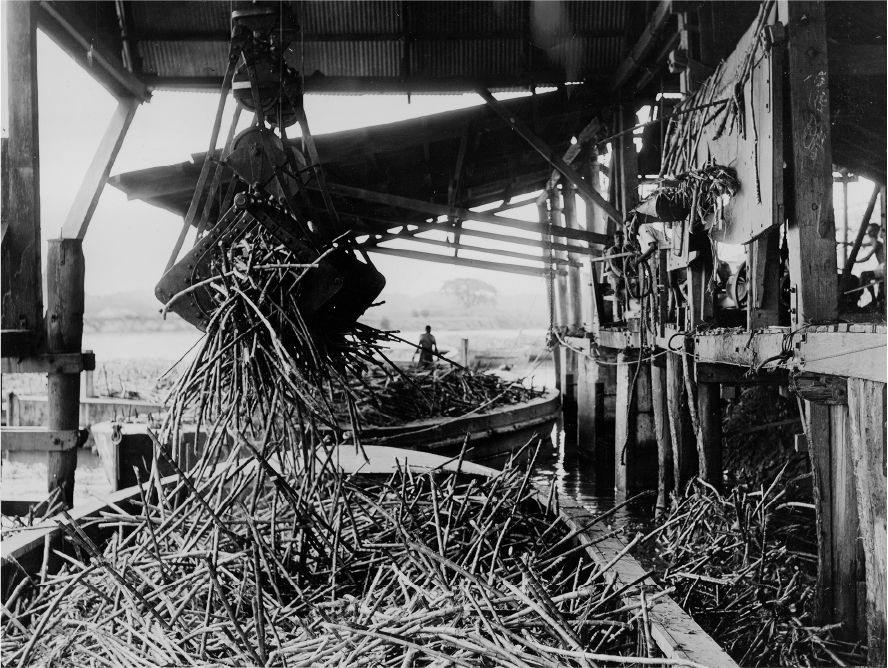
fig 12

fig 13
What becomes a glaring issue here is a handful of white men who did not belong to nor could ever understand the various iTaukei societies and cultures and their specific locales declaring that they could preserve, protect, and maintain iTaukei safety. How is this possible when colonialism was already in effect? It is also important to point out that before any European contact, Indigenous societies and communities did not have notions of country, nation, or state, and many communities had their own forms of sovereignty that cannot be codified and written into policy or law. There was nothing holy or sacred in the actions of Imperialism in Fiji, Gordon and his native policy, or the other “anti-settler” colonialists and the missions—it was always purley about profits and power.
Outside of economic and “moral” imperatives, the native policy was also a means of pacifying the growing conflicts between settlers and iTaukei. Two years prior to the native policy, Thurston himself attributed the racial conflict between settlers and iTaukei to “the lack of commercial development between 1871 and 1874 [and] to political unrest”.95 With an Indigenous population outnumbering settlers drastically and a small force of arms at the colonial administration’s disposal, and with Gordon only having one unit a part of the British Armed Forces—the Royal Engineers—for protection, the situation was becoming increasingly urgent.96 Fiji needed to have the appeal of being a safe investment at all costs, and political rule through chiefly authority could assure political stability. This was the only way forward for overseas companies to invest large amounts of capital in Fiji.97
With ordinances in place that supported Gordon’s native policy, such as Ordinance 6 of 1875 and 21 of 1880, which prohibited the sale of native land,98 Gordon set about securing Indigenous land as “inalienable”. The Crown was exempt from the inalienable status of Indigenous land, meaning that they held sole rights of purchase. This allowed the colonial administration to bring about the land-leasing system that allowed native land to be leased for 21 years, in the interests of white settlers.99 This law is inherently contradictory as Gordon believed that he was protecting iTaukei, but regardless of who the purchaser was he was still facilitating the land-theft.
With the Deed of Cession,100 settlers were now required to prove their land claims, furthering anger and hate towards Gordon, as many settlers felt it to be unjust towards their existing rights. Resolving settler land claims became a pressing issue under the new administration and needed to be resolved so that overseas investment could begin.101 There was an estimated 854,000 acres—one-fifth of the colony (some of the most fertile land in Fiji)—being claimed by settlers.102 With native leases having the possibility of being undesirable to overseas investors, of the 1,683 land claims by settlers, 517 were granted, at half the area of the original land claims, most of which was unused land. This set aside substantial freehold land so that European plantations could start being built.103

fig 14
The question of labour for these plantations became an issue as Gordon’s native policy had set about the regulations on iTaukei, restricting their movement outside of their villages. He believed that “immobility” was also part of saving them; this Native Regulation would continue to restrict iTaukei movement to and from urban centres until its abolishment in 1967.104 This restriction of movement in conjunction with the introduction of a native taxation scheme, where iTaukei would grow cash crops such as vegetation and other goods for the Government to sell for state revenue, would enable the Government to maintain “immobility” outside of the village.105 By implementing and enforcing the native taxation scheme and cash crop production on iTaukei, the Government was preventing them from seeking the more lucrative labour that was available to other non-white labourers in the colony.
These restrictions would eventually isolate both iTaukei and the soon-to-come Girmitiyas from building community together and supporting each other under a colonial regime that was violently extracting labour and land. Large-scale capitalist agriculture was allowed to thrive at the expense of iTaukei societies having full sovereignty over their Vanua. This was accomplished by segregating iTaukei from plantation agriculture through law and policy, by occupying top-quality Indigenous land,106 and by “codifying” Indigeneity through law.
Gordon’s experience in other plantation colonies, like Trinidad and Mauritius, led him to believe that the solution to the labour problem would be the introduction of Indian labourers. These racial categorisations placed people within specified roles in the colonial regime and its agenda was applied to both iTaukei and Girmitiyas. With our community not being Indigenous to the Vanua of Fiji and being isolated under the Girmit system in new lands, it was thought that our ancestors would remain subservient to their “masters”. Therefore our ancestors were cast into the role of the labourer, with colonial officials believing that centuries of Brahminical supremacy coupled with British Imperialism in the sub-continent made Girmitiyas docile and passive subjects. The first Girmitiyas arrived in Fiji in 1879, on the ship Leonidas with 498 people on board: 273 men, 146 women, 47 boys, and 32 girls.107
In 1880, Thurston departed to Sydney to make arrangements with the Colonial Sugar Refinery Company (CSR) of Australia, knowing that settlers did not have the capital that was needed to erect large-scale industrial sugar operations in Fiji. The agreement that was reached was that CSR would promote economic development and revenue in the colony and in return the government would ensure that CSR’s investments would remain profitable at all costs. A promise was made that the Government would sell 1,000 acres of land on the Rewa, the hub of sugar production at the time, for £2 an acre.108 That’s roughly £242.18 per acre today.109 CSR was given special priority by the colonial administration, for example in the preference given to CSR buying land compared to another overseas investor, Stanlake Lee and Co, who was offered five hundred acres at £3110, roughly £363.27 today.
The contradictory nature of Gordon’s land policy allowed him to approve of these sales despite his convictions of “saving” iTaukei.111 This track record of claiming to “protect” Indigenous communities and societies but in reality mining them for land and resources, would carry on throughout Gordon’s political and industrialist career. Gordon, who would later become Lord Stanmore, would eventually be the chairman of the Pacific Island Company in 1898.112 This company pushed for large-scale alienation of land in Solomon Islands to develop industrial coconut plantations, with Gordon/Lord Stanmore negotiating with the Colonial Office in the Solomon Islands for 200,000 acres. This company and Gordon/Stanmore’s violent colonial and capitalist agenda’s devastating impacts reach into the present day.
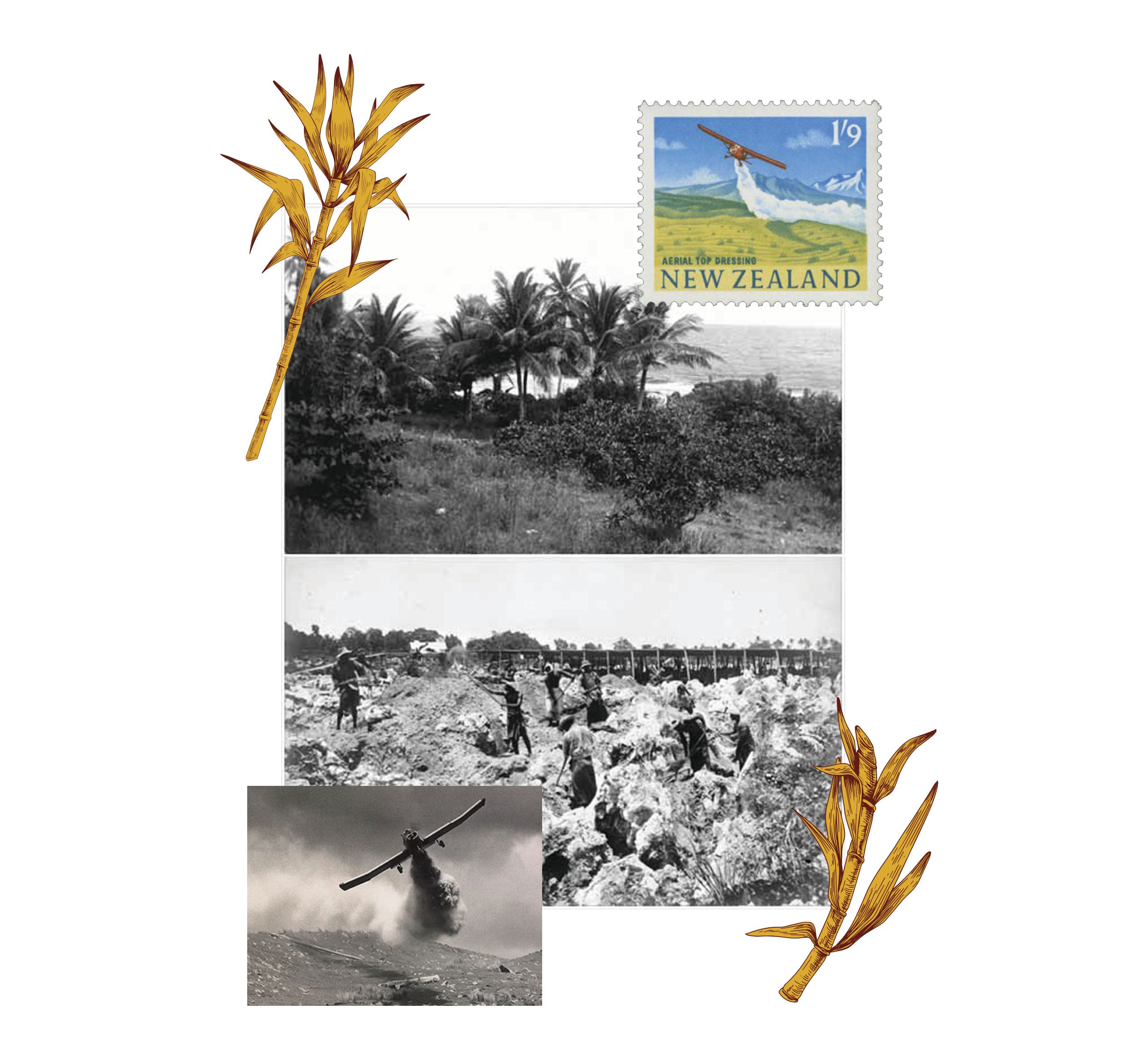
fig 15
Gordon/Stanmore would go on to secure occupation of Ocean Island (Banaba) to mine for guano,113 which was a combination of seabird and bat excrement used as fertiliser. The guano also held the remains of Banaba ancestors buried in the Whenua/Vanua. The Pacific Island Company would later branch off into Pacific Phosphate Company, with Gordon/Stanmore securing exclusive rights to mine in Banaba for 999 years at the low cost of £50 a year, with phosphates also later to be mined from Nauru Island.114
A man who had proudly claimed to settlers in Fiji “it should always be remembered that this is emphatically not a white man’s colony”,115 whose own biographer declared him to have, “solved the problems which a generation of near-anarchy and the impact of a semi-civilized purse-poor white population upon the half- barbaric and half Christianized intelligent native inhabitants had generated,”116 was in reality far from this picture he liked to paint.
Gordon/Stanmore used Fiji as an experimental space so that he could sharpen his skills for colonial and imperial economic conquest across the Pacific and it’s time that we place him within his true context. Gordon/Stanmore’s true success was in displacing and learning how to put different non-white or Indigenous communites in opposition to each other to allow the expansion of big business. Gordon/ Stanmore did not need to abide by a settler-colonial framework when there were more opportunistic and covert ways to colonise. Pacific Phosphate Company would eventually create ecological dead zones, with soil that held the bones of ancestors gone, crushed and processed with rock to become topsoil that would be used as fertiliser across farms in New Zealand and Australia.117 Gordon/Stanmore did not work alone; similar to his colonial administration in Fiji, he was aided by the business interests of New Zealand, Australia, and Britain.
I sit here writing this with such rage and heartbreak, that this man’s legacy of colonial violence has extended far beyond what I could have ever imagined. He has been lauded throughout history as someone who saved iTaukei from colonialism and claimed he was “protecting”, yet a year after his native policy he led a small force of men into Colo to erupt war against Indigenious communities who refused to convert or give their sovereignty to indirect rule.
When Gordon left Colo he burnt the village, signifying the loss of their sovereignty, and would displace over a thousand women and men to Ba and Sigatoka where they would serve out prison sentences.118 We can no longer look at these histories in isolation as they are all connected in the industrial expansion of the Empire, with sugar being one aspect of the colonial agenda that connects us to many communities across Te-Moana-nui-a-Kiwa, Oceania, and Sumandar. Tracing these histories is one part of our resilience to colonialism. To remember is an act of defiance against the systems that seek to make our histories invisible.
The Salmon-Coloured Sugar Factory
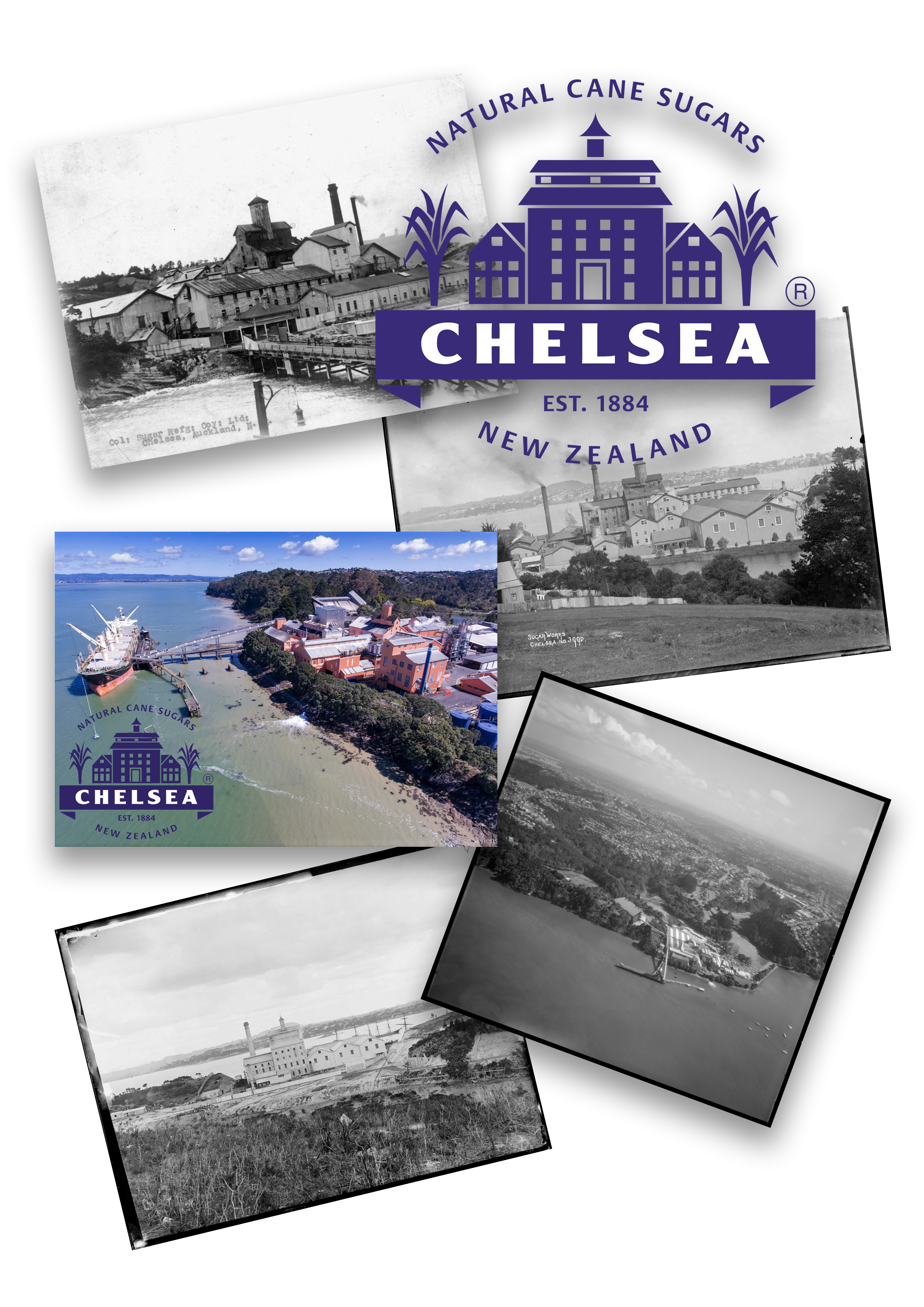
fig 16
Quishile: Nestled in the coastal line of Birkenhead, a salmon-coloured building stands. You can see it while driving across the harbour bridge, and through parts of Auckland city centre. A monument to violence, this salmon-pink structure is a sugar factory, and is considered “NZ’s trusted taste since 1884”.119
Once CSR knew that they had secured land in Fiji, with plans to build mills for crushing cane and the steady supply of labour from Girmitiyas, it was time to expand into New Zealand to ensure a monopoly on the growing market. Edward William Knox took over from his father as general manager of CSR in 1880120 and expanded the company to new corporate heights never before seen in CSR’s history. Securing a mill in New Zealand was important to the growth of the company, especially since large profits were their goal. If CSR could control all aspects of sugar—growing, labour, and mills—then they could more easily control any fluctuations in prices on the market.121 Edward William Knox himself had discussed how expanding the company was the only way forward: “Personally I should wish our operations could be restricted to New South Wales, but as sugar will be produced in Fiji sooner or later which will come into competition with ours, it is a question whether it will not be better for us to take a share in the development of the industry and in the profits.”122
New Zealand was the next step in CSR’s corporate greed and the next location to enable the Sugar Empire to prosper. Without colonisation and the violence inflicted on Indigenous and colonised communities in all three locations (Aotearoa, Viti, and Australia), both CSR and Chelsea Sugar (CS) would not be standing here today. Visiting Auckland in 1881, Edward William Knox purchased 160 acres of coastal land123 that would become the salmon-coloured sugar factory. This land would become increasingly important in CS’s history because of its access to the harbour for shipping.
The land purchase was tied to other key historical moments in New Zealand’s colo- nial history, including the Crown’s intensive land purchases in 1840 to 1865.124 The Crown during the period bought Mahurangi, where the CSR mill would sit, seeing this land as the gateway to Auckland.125 This land—100,000 acres—was bought for 400 blankets, 60 cloaks, £200 cash, 60 gowns, 2 horses, 2 head of cattle, 200 pro trousers, 30 coats, 100 caps, 4 casks of tobacco, 6 bags of flour, 2 bags of rice, and 1 bag of sugar.126 Portions of price and goods promised would take months to years to be received.127
This gateway to Auckland—a land of milk and honey—was seen as suitable for small farms that could be settled by middle-class immigrants arriving from Britain.128 The Mahurangi area—what we now know as the North Shore of Auckland—was subdivided and sold in 1845. These plots became the basis of suburban farming of what was known as “fertile Eden”.129 Birkenhead point and most of Northcote was sold to William Smellie Grahame, the agent for the New Zealand Company130, a company that was an instrumental tool in colonising Aotearoa.131
The New Zealand Company would eventually decide to focus their settlement efforts into other areas and the land reverted to the Government in 1847. The government placed the lots on Auction with the land known as Wawaroa sold to Major Collings de Jersey Grut in 1856.132 The land at Wawaroa became a failed farm where animals walked off into the bush and servants left to pursue their own lives. Major Collings de Jersey Grut would sell Wawaroa in 188,133 known as Duck Creek at this point, finally transforming this land to the CS mill.
With Edward William Knox’s purchase in 1881, to monopolise the market, CSR had also answered the New Zealand Government’s offer for money to whoever could set up the country’s first sugar factory.134 CS would be formed with Victoria Sugar Company (VSC), CSR, and a collection of New Zealand colonialist businessmen such as Horton, L. D. Nathan, W. S. Wilson, and Sir Frederick Whitaker135 (whose colonial exploitation exceeds them). This business venture would become known as the New Zealand Sugar Company, more commonly known as the Chelsea Sugar Refinery.
All these moments, decisions, and politics in the name of colonial expansion would lead to the construction of the Chelsea Sugar factory in 1882, with one million and a half clay bricks136 moulded, sculpted, and taken from the Whenua, the Vanua of this new site that would be an “industrial enterprise.” New Zealand’s trusted taste, built and made from colonial exploits and abuse across the Pacific, would be erected as a site of pride in the settler narrative of New Zealand.
It would take 18 months for the construction of the CS refinery to be completed, and it was fully operational by 1884. In 1887, with the collapse of the sugar market, CSR would absorb the shares of VSC and the New Zealand businessmen who invested, making Chelsea Sugar distinctively Australian-owned.137 This decision worked best as CSR was driven by its shareholders and “they do not forget the results which must be achieved for their ultimate employers, the twelve thousand shareholders”,138 with the majority of shareholders at this time being New South Wales businessmen.139
Under the management of Edward William Knox, all mills that were owned under CSR would employ strict control in the names of profit, with accountancy being a key tool used to enforce dominance. As Foucault has stated, “[t]his style of governance is concerned with exercising control at a distance, as opposed to the threats of violence that characterised previous ages.”140 While this statement was true for the white, male, working-class labour force of CS and CSR, being afforded a life free of physical violence was not provided to our ancestors in Fiji; rather, it would define their treatment under Girmit. This is why history is remembered very differently for those who worked for CSR in New Zealand and Australia, versus how we as Girmit descendents remember our history. CSR and Edward William Knox’s system worked by dividing people along class and racial hierarchies that intersected harsh management styles, keeping people in their place within the working chain.

fig 17
Accountancy was used as a means of record-keeping that controlled waged labour and production output. With a head office in Sydney, large quantities of information was required to be sent regularly. Weekly reports would monitor stock: raw sugar, hessian cloth, bags, coke, coal, syrup, and molasses. These reports would come with a letter from the refinery manager, giving updates on weekly production, the workforce, and machinery issues,141 with a six-monthly report that would go into further detail, documenting individual wages of each employee. This would be broken down into age, hours per week worked, tasks, and wages per week alongside the duration of services provided.142
This process of constant stocktake and surveillance of the workforce would enforce an ideology of being constantly watched, with many workers stating their distrust in floor managers, accountants, and other higher staff. Workers stated that records were the “eyes of the company... eyes that were always on them.”143 This type of extreme surveillance was a part of an economic model that sought to extract as much labour for as little as possible. Edward William Knox would use his extensive documents to keep workers in line, to ensure that wages were always paid in accordance with what the Company thought “fair”. This would lead to CSR being the largest industrial organisation in Australia in the early 1900s.144 By 1915, CSR would control 90% of the refined sugar production in Australia and 100% in New Zealand.145
The use of accountancy as surveillance on white wage labourers was only possible through the policing of Girmityas bodies, as someone had to produce the raw sugar. Yet when it comes to how history remembers these different communities of labourers, we continue to feel the impacts of colonialism; we are the ones who have not been afforded generational resources, we are still policed and monitored by states that seek to make our ancestors labour invisible.146 While the colonists and their administrations inherited wealth in their economies, we inherited intergenerational trauma from a system that only saw our bodies as human capital.
Instead of reports and letters, Girmitiyas labour was set within a tasking system, which became popular in the 19th century as a way to maximise more productivity. The tasking system involved measuring labour through the products of labour instead of hours worked. The physical demands of plantation tasking is seen best through chains: a unit of measurement designed to calculate visual labour. Tasks were usually between 5 and 10 chains in a day, each chain being approximately 20 metres of tasks such as bush-clearing, weeding, or planting.147 Planters would further exploit these opportunities by taking part of labourers’ wages as punishment for being absent or turning up late,148 and “some places used the practice of a ‘double cut’ by which they docked two days’ pay for each day the labourer was away from work.”149 And sometimes Girmityas would choose to forfeit payment instead of going to the fields to work.150

fig 18
This system functioned at the convenience of plantation owners and overseers as they saved money calculating work through these physical and visually measurable products of labour instead of hours worked. This also became a means of inflicting abuse as tasking gave more power to overseers, who could easily deny or underpay if they felt the output/productivity was not high enough.151 Physical labour became almost impossible to complete, with ridiculous expectations of task labour, lack of healthcare and food, and physical abuse.152
In 1896, an ordinance was passed that convicted Girmitiya for three months with hard labour or fined three shillings per day for unlawful absence.153 An older ordinance, passed in 1886, was implemented to stop mobility of labourers when they tried to lay complaints about their overseers. It became unlawful for more than five people on one plantation to be absent at the same time. Girmitiyas could not visit their employer’s office or house and they could not visit the office of any public official to report or complain about abuse. The punishment for such offences would result in fines of £1 or one month’s imprisonment with hard labour.154
Another ordinance in 1891 would allow plantations to charge Girmitiyas for causing a disturbance and refusing to go back to work.155 Labasa, due to its isolation and lack of inspections, saw the highest rates of complaints laid against Girmitiyas, with 96% of the Girmitiya population having a complaint laid against them in 1895, 68% in 1896, 90% in 1898 and 68% in 1899. Most of the complaints would lead to prosecution. In labour offences laid against Girmitya, 82% in Fiji were convicted, while in comparison the offences laid by Girmitiyas to plantation overseers only lead to 35% of convictions.156
With CSR being the main “employer” of Girmitiyas and plantations, they exercised their power through ordinances and a reliance on government to not interfere with what a master did with his coolie. This complicity or willful ignorance to the situation would allow CSR to rule in Fiji through mental and physical force, as many Girmitiyas stated, “Company ka raj’.”157 This harsh and inhumane system of extracting labour for as little as possible could not have worked without a chain of command, with the racialised “Other” sitting at the bottom. Although the Girmit, or contract, stated the daily wage for men being one shilling a day and women nine pennies, in reality these amounts were never paid in full. It would take 28 years after the first ship, Leonidas, arrived in Levuka in 1879 for adult men to earn an average wage of one shilling per working day.158 It is not recorded if women finally got their average wage of nine pennies a day, but I would suspect that it was no different, and that it took even longer in their case.
Meanwhile in New Zealand, CS’s average wages of a refinery worker in 1912 was £120, £700 for a refinery manager’s salary, and £1,100 for the Auckland general manager.159 It’s hard to believe that when Girmitiya women led the labour strikes in 1920 in the Suva-Rewa area, they were fighting for a minimum living wage of five shillings per day.160 But due to their requests for better payment and living conditions, our ancestors were seen as a threat to the European population.
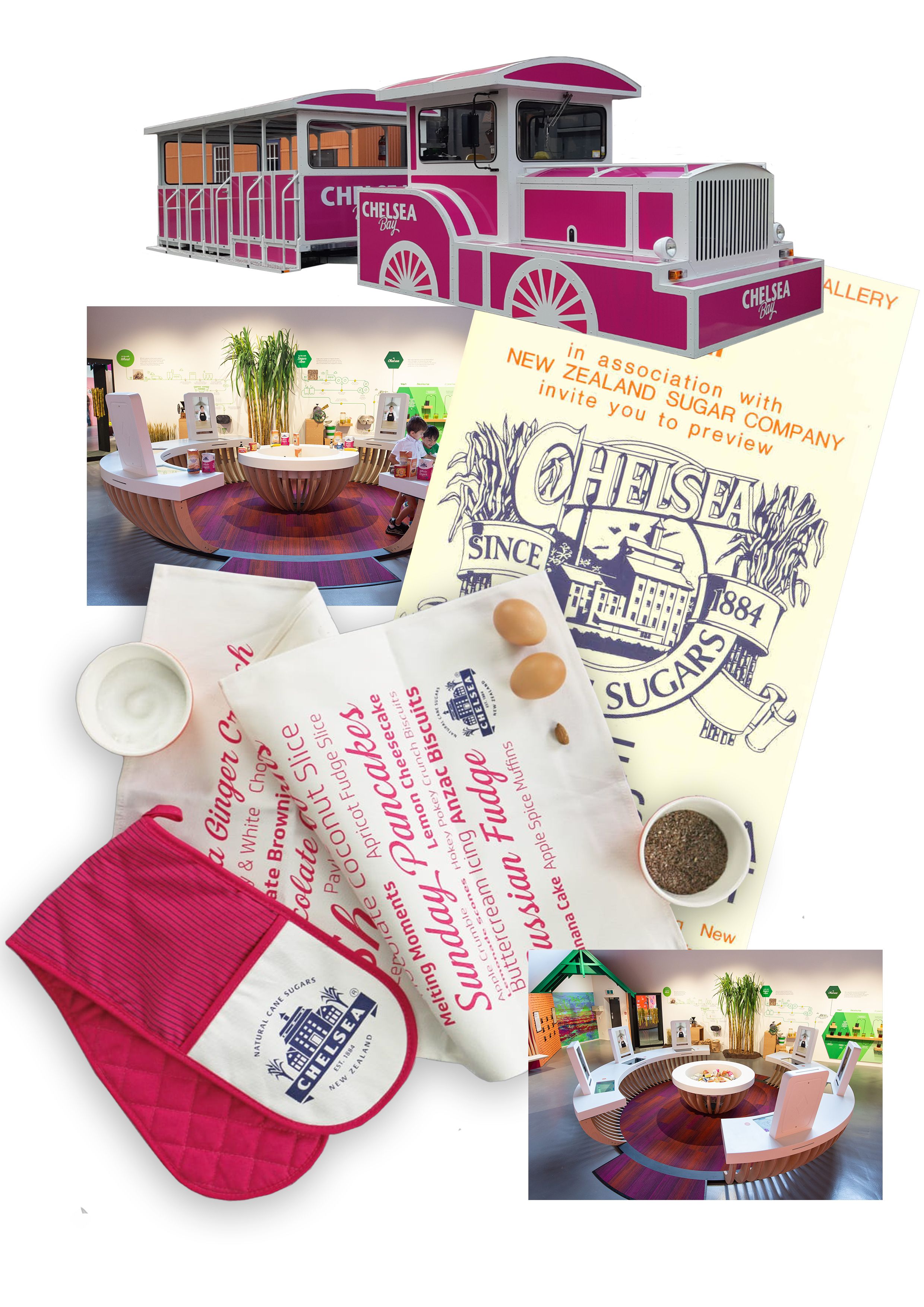
fig 19
We were seen as a threat when demanding the basic human rights our ancestors deserved, so much so that “Governor Rodwell sought support from Australia and New Zealand and by 12 February 60 New Zealand troops with Lewis gun sections arrived and were placed at the Suva and Nausori police stations. On 14 February the Australian government’s warship—the Marguerite—arrived. They were armed and ready to ‘overawe coloured population and reassure [the European] public.’”161
While there is no doubt that workers in CS and CSR experienced class-based discrimination, it is startling to see no historical evidence of solidarity between Pākehā and Girmitiyas, despite the growing class-consciousness amongst the European labours. New Zealand and Australia as colonial settler-states are fully active in these acts of placing our ancestors as unworthy of solidarity. During the Girmit era, news and stories of indenture were not unknown; they would travel between Fiji, New Zealand, and Australia through newspaper articles. I believe that it’s a pretty lazy argument when people try to excuse the lack of caring as lack of knowledge. During this era, even if information in news articles was minimal, there was enough there to trigger alarm bells.
During this era of early settlership, “New Zealanders” were trying to bring forth a “Britain of the South Seas”, racial hierarchies and all. There was a constant underlying fear among the large working-class white settler populus of an “invasion” of non-white labours. Class solidarity was not extended to non-white labourers, especially indentured labourers, because settlers inherently believed them to be “naturally and biologically” inferior and suited to harsh degrading labour.162 While having a white and male workforce is different to the context of our ancestors, it cannot be overlooked that CS used similar tactics from Fiji to manage its working-class labour force in New Zealand. But we experienced a different kind of brutalisation. The difference between those labourers’ histories and ours, is that ours still holds the weight of intergenerational trauma; while one set of people get to build a nation, we were the tools for them to do so.
Even after the abolishment of Girmit in 1920, CSR continued to build its sugar empire but cutting out the middle-man in Fiji: white plantation owners, who up until this point worked for CSR through the means of cultivation. CSR had reluctantly gone into leasing land to European planters due to their lack of capital. This land- leasing strategy would result in planters leaving the Colony due to being heavily mortgaged and bankrupt.163 CSR would instead divide their plantation estates into small farm blocks of 10 acres, leasing these plots to Girmitiyas.
By phasing out the white planter, CSR could continue to maximise profits through offering a lower price for cane to Girmitiyas.164 It was thought that land-leasing would be a more humane option compared to Girmit, one that supported the nuclear family, by which land was leased to a man, enforcing marriage onto Girmitiya women and relying heavily on families being the labourers. With raw material and not labour not being paid, the sugar profits grew for CSR during this period. With a war, slumps in the global market, and white planters eliminated, CSR would make superprofits of 13 million pounds—its most profitable period (1914- 1923), a “monetary success in its history”.165
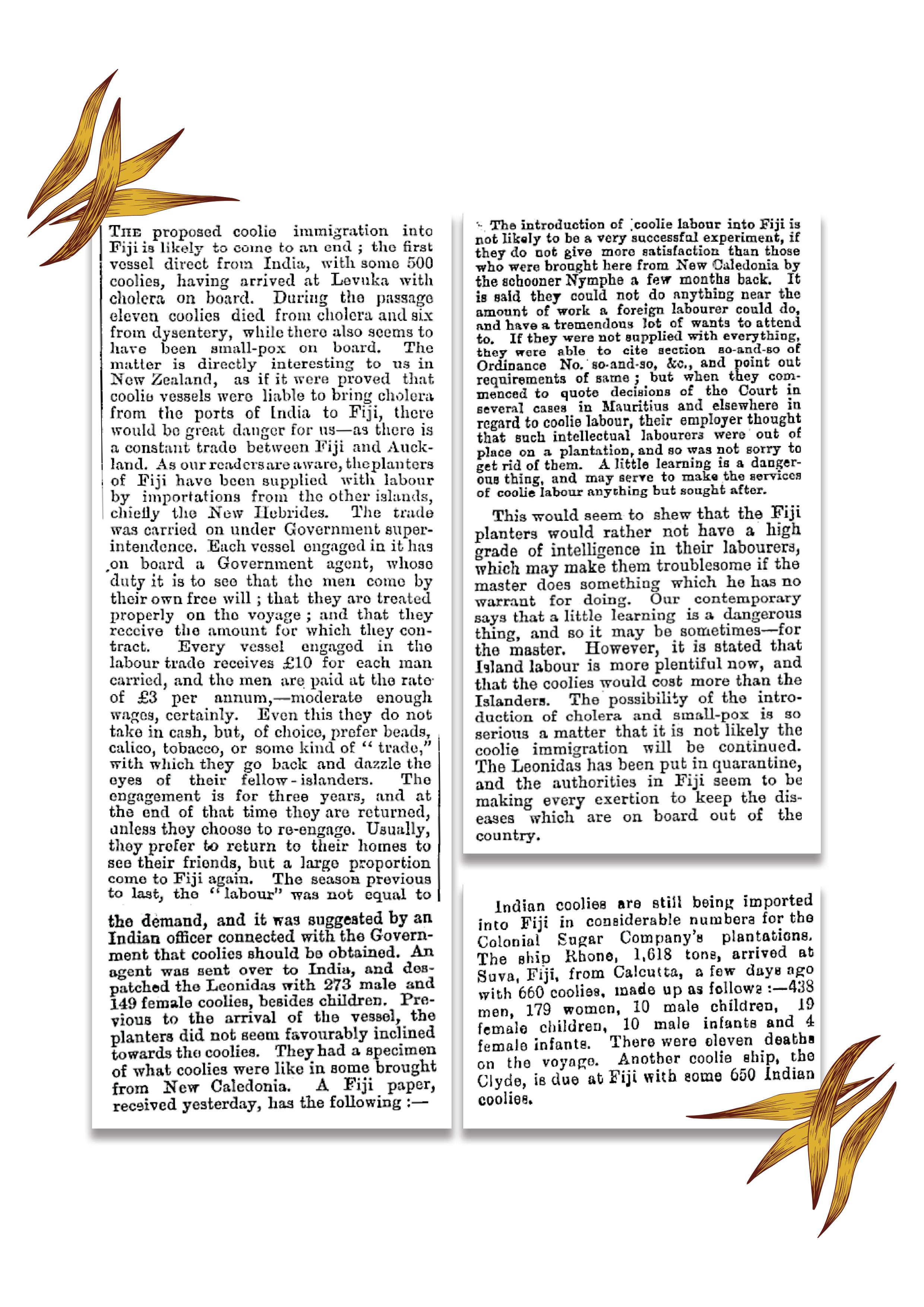
fig 20
Through this land-leasing system, costs could remain low, which meant CSR could still compete with global prices, with New Zealand benefiting from this enormously due to the discounted rates for sugar they received in this period,166 for which the New Zealand Government thanked the company.167 Through using a landlord system, controlling all aspects of production, the long racist history of CSR amalgamated into a more complex system of capitalism and colonialism. A CSR official pointed out that “From the number of women and children working on the smaller farms it is evident that the leasing of the land has increased the number of workers in the industry.”168
A few thousand miles away in both Australia and New Zealand, this colonial abuse was normalised (and still is). Considering New Zealand and Australia’s violent histories of settlership, should we expect the state or the companies involved to step forward and take responsibility? The many successes of CSR and CS include that it has normalised its colonial and capitalist abuse and violence through domesticating it, through linking it forever to the landscape of the home, but not to any household, visually linking itself to the working-class and middle-class white families of New Zealand.
In 2017, CS teamed up with Edmonds cooking, the iconic baking brand and cookbook series,169 to open up a $7 million tourist destination, celebrating both of their histories of settlership through a cafe espousing tourist glee.170 This tourist venture enforces how white settlers are allowed their histories to be memorialised through historic buildings, monuments, and walkways such as the salmon-coloured factory and Chelsea Estate Heritage Park.171
The general manager in 2017 stated that, “[With] more and more Kiwis wanting to know where their food comes from, we wanted to do something that would open our doors and show a whole new generation of Kiwi’s how we operate.”172 But will Chelsea Sugar ever be honest about where their sugar came from, who they exploited and abused? It seems that those types of histories—of colonialism and capitalism—just aren’t as sweet and comforting as a baking school, a cafe, and an interactive history exhibition.
Esha: Sugar, tourism, and heritage all go hand-in-hand and impact one another. Depending on your heritage, the significance of these foods, histories, and legacies of sugar colonialism will weigh differently. Before tourism was a massive industry, “sweets were an expensive luxury” and “sugar confectionary [was] synonymous with tourism and the holiday.”173 Tourism started as a colonial tool so the Empire could showcase “exotic” places and people, and tourism to this day continues this colonial violence of escaping to paradise. Especially all the eat-pray- love types wanting to discover themselves in “mystical” countries or the savior- volunteer trips for the more socially conscious (~gross~) members of society.
For the Empire and colonisers, sugar offered them the opportunity for a worldly or classy—classist—experience, but what about the communities and labourers who were actually producing the sugar?
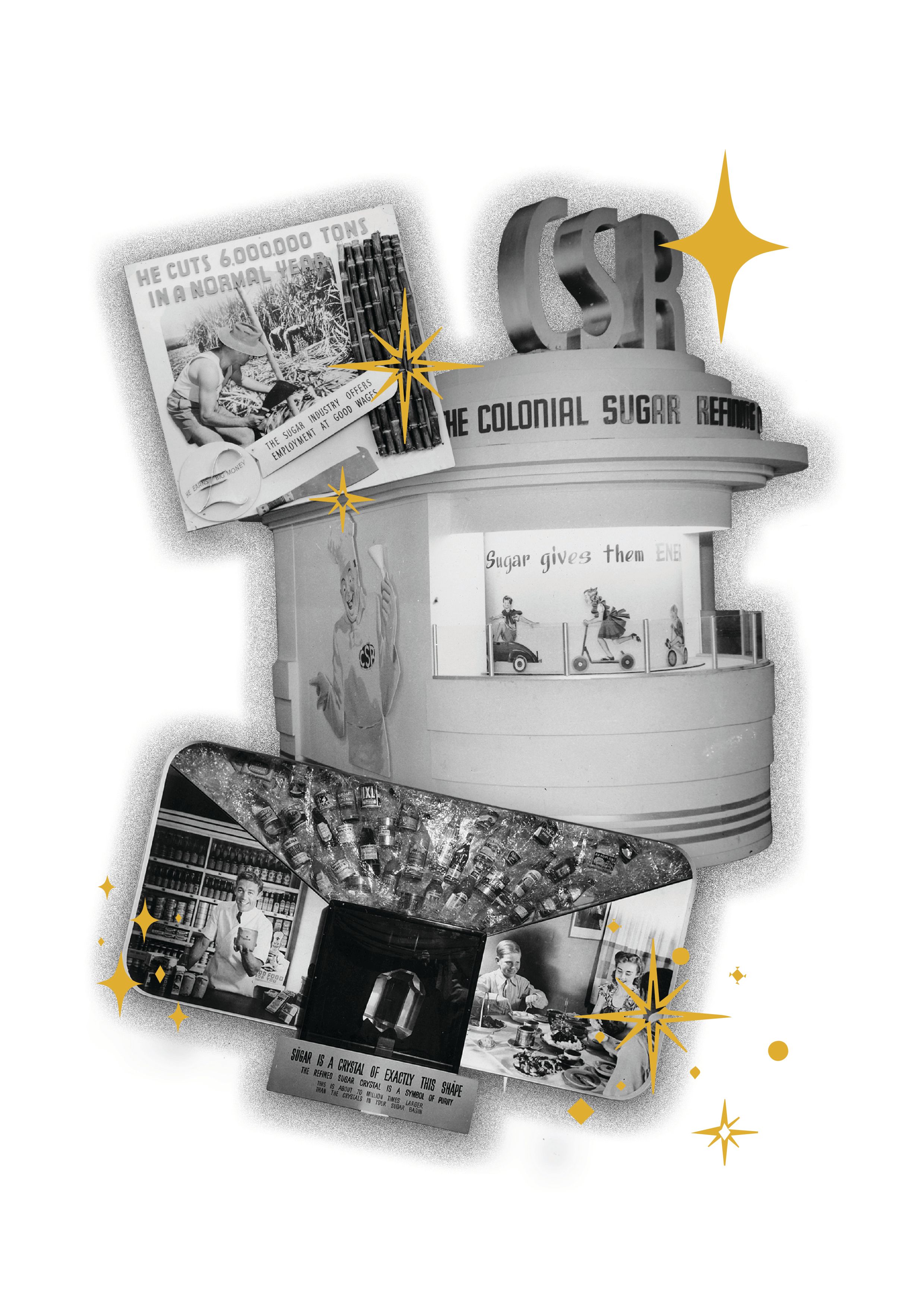
fig 21
Quishile: The history of Girmit and the Sugar Empire in the Pacifc has been replaced in contemporary consciousness with cheerful memories of the 1980s and 1990s, when tours had begun with ten of thousands visitors who would come to see the famous sugar mountain that holds 40,000 tons of raw sugar. Now with the reopening of the Chelsea Sugar tours in 2017, coupled with Edmond’s baking school, those cheerful settler memories of a mythical “sweet story” behind this sugar company can thrive.
Whose history is remembered, because it certainly is not mine or my community’s, or the various other communities harmed in the name of sugar. While Chelsea got to rebrand, redesign, and open a cafe, the communities who built this wealth are dealing with the devastating effects today. Neither CSR nor CS have made attempts at paying reparations, nor offered relief packages to Fiji dealing with the onslaught of climate change because of industrial agriculture and colonialism. Neither one has made an attempt to make an apology, nor admit to their histories of brutality and cruelty, not even on their websites. And what I have listed is just the bare-minimum in acknowledging and accounting for their colonial greed. Out of sight, out of mind.
What is almost amusing in this situation is the pride that seems to scream across the many articles and internet pages I found praising CS for its distinctively New Zealand history, how iconic this location is. In reality, this distinctive New Zealand bit of history and geography would continue to be owned by CSR until recently, with CSR selling their sugar assets, which included the New Zealand Sugar Company, to Singapore commodity trading company Wilmar International in 2010: “Wilmar International is to pay A$1.75 billion ($2.14 billion) to buy the sugar assets of Australian conglomerate CSR”.174 Wilmar International, the world’s largest palm oil trader, is owned by the Kuok family, with Robert Kuok known as the “sugar king”.175 CSR stated that the sale was good as they could focus on the other aspects of the company such as its building-products business
This salmon-coloured, candy floss-coloured factory has been forged into history through the myths of colonialism and capitalism, and New Zealand has spent years complicit in this violence. CS painted its buildings in the 1990s from green and brown to the “Tuscan Red” we see today. I wonder if painting it in hues of pinky reds helps conceal the violence. I often stop in the supermarket aisle where the Chelsea Sugar bags are stacked, thinking of my family’s sugarcane farm in Nadi. Was our ganna khet subdivided into plots from the same plantation estates my ancestors worked? I think of the death of my Aja in the harvest, I think of all the unnecessary lives that have been lost in the name of sugar, not just in my community but globally. Those pink and white bags, that salmon-coloured building, their PR stunts to bury the truth. I’ll never forget as these histories are bound to my bones.
Conclusion
Quishile: I have been holding onto grief for so long, it is a type of grief that I cannot find words for but it has been manifesting generation after generation, after seeing and knowing the pain and trauma of Girmit and the various other systems of colonisation that have impacted my community. This writing has been an act of putting this grief into action, of trying to place words to a history so bound to my bones, to histories buried in the soil of the Vanua in Fiji. I think of how plantations were divided then subdivided for small farms, that one day my family would lease a ganna khet and I wonder, did my ancestors work those fields, do they feel me as I feel them when I am home in Nawaicoba. Aaji once said, long after we are gone, the ganna will always remember. To revisit this pain has been an act of healing, of understanding and placing my histories within a wider context of colonialism and imperialism across Te-Moana-Nui-a-Kiwa, within Aotearoa and Australia. The struggle is together and the fight must always remain in solidarity. Even though many communities across these oceans have experienced colonisation differently we are all still affected today from these overarching systems.
I often think of the mythology of history—who gets to exist and who is forgotten. I never knew how interconnected my ancestors’ colonisation was with other communities, how it has been impacting, unravelling, and feeding into our lives today. I often think of how sugar defines our lives today, in the food we eat, the imported diseases of Empire—diabetes, and heart disease.
Writing has been an act of bringing our many memories and stories together— the pain, the grief, and of course the love and joy we share with each other. Our stories and sharing these stories are part of our ongoing resistance. To my Whanau, both chosen and those who I am born to, you have brought me here today and I am so very blessed to be here, to tell these stories, to share these memories for the next generation.
Esha: One of my Attas, or Athai (father’s sister), in Wailevu adores and cares for her plants, flowers, and garden on a daily basis. In addition to running her household, she would also spend a significant amount of time every day in her front yard. When I was back in Fiji, any time I went to someone’s house or if anyone came over, people would be talking about their gardens with each other, seeing who was growing what and if it was going well. I would hear my Atta talking about her fobia176 flowers a lot. And the different kinds of fobias she was experimenting with.
Back in California, my Badamma (mother’s sister) is also an amazing planter. In addition to growing different plants, my Badamma gives many of them to other family members and friends to grow as well, or simply as a gift. As I am learning more about plants, and how to grow them by myself, I am understanding how important planting is to the women around me, as well as other relatives who take their gardens very seriously—as they should. From food to medicine and decoration, planting, flowers, and gardens are valuable across communities in Fiji. It’s all part of the environment.
Deforestation177 and sugar go hand in hand. So when we look at the histories of sugar and sugar production at an industrial level, the devastating impacts it’s had on the land and to Indigenous communities from very early on is horrifying. I am, of course, not the best or most knowledgeable person to speak on the climate crisis and all the different structures (and histories of colonial violence) that have contributed to this violence in the Pacific. But there is definitely a direct link between climate change and disruption and the history of sugar slavery and colonialism. Sugar farms, mills, and plantation economies wouldn’t exist without destroying different ecosystems in the process.
Writing this essay was important because I think to understand my own histories as a descendant of indentured labour, or Girmit, it’s only responsible to learn and understand the histories and stories of other communities who have experienced the violence of sugar. This essay, like our first one, is just another beginning of diving deeper into histories connected to Girmit, but I do hope for those who read it, that it gives a better understanding of why practicing solidarity across communities is necessary to dismantle all forms of supremacies. If those of us who come from colonised communities look to our ancestors to understand our history, whether it’s colonisation by European powers, Brahminical or Aryan supremacy,178 state-led imperialism, and/or military occupation, then I do believe that those who either benefit or are complicit in these oppressive histories and violence should also examine their position.
Finally, writing and researching during this time was difficult for me. It was an isolating experience, even more so during a pandemic. I would like to say Vinaka vaka levu to Quishile for sharing the labour of researching and writing for this essay, and for all the labour and time for your making, craft, and textiles. I would also like to shout out my loves who provide me with so much kindness and support, with so many things, thank you to Maari, Yasmine, Bava, Harleena, and Nirnoy. I am also grateful to my Attas, Badamma, and cousins who share so many great stories with me. Lastly, I’m thankful for my niece, Delilah, who brings so much joy and meaning to my life every day.
End Notes
1
Ngata, Kia Mau: Resisting Colonial Fictions, 11–12.
2
Many of the narratives of Fiji Girmit are written so the sole focus is on how our community was displaced and harmed by the Indentured Labour system (Chalo Jahaji by Brij Lal, The Violence of Indenture in Fiji by Vijay Naidu, Tears in Paradise: Suffering and Struggles of Indians by Rajendra Prasad). I have yet to see any attempt to connect this history of economic domination through sugar in the South Pacifc to the harm done to the various Indigenous communities across Te-Moana-nui-a-Kiwa. For creating a future of sustainable solitary, I strongly believe we must be able to see how our histories are interconnected with other communities that have been displaced and harmed by colonialism, to see that our struggles and fight are connected and we will only be free through working together in meaningful ways.
3
Higgs, Behind the Smile: Negotiating and Transforming the Tourism- Imposed Identity of Bahamian Women, 20.
4
Legget, “Chapter 11: From Sugar as Industry to Sugar as Heritage: Changing Perceptions of the Chelsea Sugar Works,” 190.
5
Warner, John. “Sugar Cane: An Indigenous Papuan Cultigen,” 406. Also see “History of Sugar” timeline. The Sugar Association. https://www.sugar.org/ sugar/history/
6
Baru, “Sugar in History: Sweetness and Power,” 1391.
7
Goodall, “How England became the ‘sweetshop of Europe.’’’ The Crusades were a series of wars, murders, and genocides that was used to justify the expansion and conquest of European Christianity. This specific Crusade into Jerusalem was organised by western rulers, the Pope, and the Byzantine Empire to establish a Christian domination of the region, or the “Holy Land”, as they believed that the spread of Islam had gone too far. The irony in this organised massacre was that prior to the Crusades, a significant part of history—which is constantly denied to this day—is that Black Muslims from the African continent came over to Spain in 711 CE and literally civilised the white populations. In addition to bringing universal education (99 percent of Christian Europe was illiterate at the time), science, and math, the Moors also built 600 public baths while “the monarchs of Germany, France, and England convinced their subjects that cleanliness was a sin.” Read more here: Chengu, Garikai. “History: How African Muslims ‘civilized Spain.'" Pambazuka News. April 20, 2017. Propaganda of colonial empires and supremacist ideologies never really go away. The Christchurch shootings and attacks, on March 15 2019, was led by a white supremacist who carried assault rifles and automatic shotguns and referenced the Crusades from the 12th Century CE (Jones, “What the Far Right Gets Wrong About the Crusades”). In comparison, local rugby team the Canterbury Crusaders, has had match rituals that for a long time included knights on horses to “entertain the crowd” (Crothers & O’Brien, “The Contexts of the Christchurch terror attacks: social science perspectives,” 249). It seems like insignificant fun until you closely examine the history of these kinds of symbols and the role they have played in New Zealand.
8
Sugar, Cocoa, and Slavery in Portuguese Colonial Africa. March 24, 2020. Public blog and website for the course African and African American Studies 119x: Chocolate, Culture, and the Politics of Food, designed and taught by Carla D. Martin at Harvard University in the spring semesters of 2013, 2014, and 2015. All posts are written and published anonymously by undergraduate and graduate students enrolled in the course. https://chocolateclass.wordpress.com/2020/03/24/sugar-cocoa-and-slavery-in-portuguese-colonial-africa/
9
The Understanding Slavery Initiative, “Planation Life.” The Understanding Slavery initiative (USI) is a national learning project that supports the teaching and learning of transatlantic slavery and its legacies using museum and heritage collections.
10
São Tomé and Principe is an island country off the west coast of Central Africa.
11
Canary Islands are located southwest of Spain and off the coast of Morocco. Further reading: “Oldest Cemetery Of African Slaves Found In Canary Islands.” January 19, 2017. The Archaeology News Network (TANN). https://archaeologynewsnetwork.blogspot.com/2017/01/oldest-cemetery-of-africanslaves-found.html
12
For more information see: Traylor, Dean. “Who Were the Guanches of the Canary Islands?” Owlcation, July 26, 2018. https://owlcation.com/humanities/Who-Were-the-Guanches-of-the-Canary-Islands
13
Mucci, “The Illustrated History of How Sugar Conquered the World.”
14
“Portugal, Sugar, and the African Slave Trade.” August 11, 2017. Worldhistory.us.https://worldhistory.us/american-history/portugal-sugar-and-the-african-slave-trade.php
15
Muhammad, “The sugar that saturates the American diet has a barbaric history as the ‘white gold’ that fueled slavery.”
16
Schomburg Center for Research in Black Culture, Jean Blackwell Hutson Research and Reference Division, The New York Public Library. (1899). Slave trade of Africa Retrieved from https://digitalcollections.nypl.org/items/510d47df-fd20-
a3d9-e040-e00a180617
Muhammad, “The sugar that saturates the American diet has a barbaric history as the ‘white gold’ that fueled slavery.
18
Mintz and McNeil. “The Middle Passage.”
19
Chattel slavery in the US depended on the reproduction of enslaved African people for the labouring population, while Brazil and other countries in South America and the Caribbean continued to bring more people from the African continent. To learn more about the sexual chattel slavery of Black women and people and the impacts of this violent history read: Goodwin, Michele. “The Racist History of Abortion and Midwifery Bans.” American Civil Liberties Union (ACLU), July 1, 2020. https://www.aclu.org/news/racial-justice/the-racist-history-of-abortion-andmidwifery-bans/
20
The Guardian. “Britain is built on sugar: our national sweet tooth defines us.”
21
Australian Sugar Heritage Centre, “The History of the Sugar Industry.”
22
Liddle, "Why a connection to country is so important to Aboriginal communities."
23
The Healing Foundation, “Stolen Generations.”
24
McQuire, “Opinion: Australia is outraged over George Floyd. But what about black lives on our shores?”
25
Ibid.
26
Ibid.
27
The Healing Foundation, “Timeline of Trauma and Healing in Australia.” “This timeline looks at some of the events, trauma and healing that’s taken place in Aboriginal and Torres Strait Islander communities over the last two and a half
centuries. The dates in this timeline are a selection representing the breadth of events that have occurred. This is not intended to be a complete list.”28
Daley, “Colonial Australia’s foundation is stained with the profits of British
slavery.”29
Coventry, “Links in the Chain: British slavery, Victoria and South Australia.”
30
This included a minority group of non-Europeans as well, but the majority of convicts were white men and a smaller population of white women and children.
31
Gascoigne, “From Captain Cook to the First Fleet: how Botany Bay was chosen over Africa as a new British penal colony.”
32
Novak, “Britain Sent Thousands of Its Convicts to America, Not Just Australia. ”
33
Lockhart, P.R. “How slavery became America’s first big business.”
34
Gleeson, "From Louisiana to Queensland: how American slaveowners started again in Australia."
35
Irvine, “Sweet and sour: Accounting for South Sea Islanders labour at a North Queensland sugar mill in the late 1800s,” 6.
36
Ibid.
37
Davis, “Australia’s hidden history of slavery: the government divides to conquer.”
38
Irvine, “Sweet and sour: Accounting for South Sea Islanders labour at a North Queensland sugar mill in the late 1800s,” 25.
39
Higgs, Behind the Smile: Negotiating and Transforming the Tourism-Imposed Identity of Bahamian Women, 32.
40
Minniecon, “‘Let’s Sit And Talk’ Says Great Granddaughter Of A Blackbirding Slave.”
41
Jasmine Togo-Brisby Postcard. An Australian South Sea Islander (Vanuatu) Multidisciplinary Artist, Postcards Unlocked #40. May 14, 2020. Tautai
Contemporary Pacific Arts Trust.42
Davis, “Australia’s hidden history of slavery: the government divides to conquer.”
43
Moore, “Information Sheet 10: Benjamin Boyd and the Importation of South Sea
58 Islanders into New South Wales in 1847.”44
Lauder and Reardon, “Minister seeks brief on renaming Ben Boyd National Park
to address its namesake’s blackbirding history.”45
Monument Australia, “Ben Boyd.”
46
Walsh, “Boyd, Benjamin (Ben) (1801–1851)”, Australian Dictionary of Biography, National Centre of Biography, Australian National University.
47
Gregoire, "Forgotten Australian Slavery: An Interview with ASSI-PJ President Emelda Davis."
48
Doherty,“‘Full truth’: descendants of Australia’s ‘blackbirded’ islanders want pioneer statues amended.”
49
Australian South Sea Islander Stories, “Australian South Sea Islander History Month.”
50
Bobongie for Indigenous X, “In a world where everyone talks and no one listens, a good photo can make us stop.”
51
Cre8tive Nations is an Aboriginal and Torres Strait Islander owned company that specialises in cultural knowledges, creative industries and special event projects. Website: https://creativenations.com.au/
52
Monument Australia, “Robert Towns.”
53
Farnfield, “Cotton and the Search for an Agricultural Staple in Early Queensland,” 25.
54
Smith, “Statue of slave trader painted with bloodied hands in Townsville.”
55
This paper won’t go in depth about how colonialism sustains itself on sexual violence, but I do think it’s important to mention how sexual violence is also a key component of colonialism and any kind of anti-Black and anti-Indigenous violence based on various supremacies.
56
McKinnon, “Blackbirds: Australia’s hidden slave trade history.”
57
Kwai, “‘No Slavery in Australia’? These Pacific Islanders Tell a Different Story.”
58
The city of Mackay is named after coloniser and Blackbirding trader John Mackay. Read more here: https://www.dailymercury.com.au/news/was-john-mackaya-
blackbirder/3150206/59
Van Extel, Cathy. “Australia’s ‘Sugar Slaves’ remembered.”
60
Sugar was called “white gold” because it made so much money via the Transatlantic Slave Trade. Read more: https://www.dailysabah.com/feature/2017/10/06/white-gold-the-story-of-sugar
61
Christopher, “Legacies Of Slave Ownership: An Illegitimate Offspring: South Sea Islanders, Queensland Sugar, and the Heirs of the British Atlantic Slave Complex,” 244.
62
Christopher, “Legacies Of Slave Ownership: An Illegitimate Offspring: South Sea Islanders, Queensland Sugar, and the Heirs of the British Atlantic Slave Complex,” 245.
63
Ibid.
64
Historic Ormiston House, “The Sugar Mill.”
65
Ryan, “Captain Louis Hope and Cleveland/Ormiston,” 4.
66
Irvine, “Sweet and sour: Accounting for South Sea Islanders labour at a North Queensland sugar mill in the late 1800s,” 3.
67
Irvine, “Sweet and sour: Accounting for South Sea Islanders labour at a North Queensland sugar mill in the late 1800s,” 3.
68
Oral testimonies from Cheer and Reeves, “Roots tourism: blackbirding and the south sea islander diaspora,” 254. Also, after the White Australia Policy, among the South Sea Islanders who were forced to leave/deported from Australia, some also had Aboriginal ancestry. Read to learn more about these descendants who have made trips from Vanuatu back to Australia: https://www.abc.net.au/news/2018-05-05/
descendants-of-indigenous-australians-in-vanuatu-seek-reunions/972610269
Ziyad. “Why we need to stop excluding Black populations from ideas of who is
‘Indigenous.’”70
Christopher, “Legacies Of Slave Ownership: An Illegitimate Offspring: South Sea Islanders, Queensland Sugar, and the Heirs of the British Atlantic Slave Complex,” 234.
71
Thompson, “Coral Consciousness,” 33.
72
Knapman, Fiji’s economic history, 1874–1939: Studies of Capitalist Colonial Development, 3.
73
Radio New Zealand, “First cyclone of 2021 forms off Fiji.”
74
Close-Barry, A Mission Divided: Race, Culture and Colonialism in Fiji’s Methodist Mission, 2.
75
Quoted from: New Zealand History, “Kororāreka - A frontier of chaos?”
76
Quoted from: New Zealand History, “Kororāreka - A frontier of chaos?”
77
Deadly Story, “Frontier Wars.”
78
Veracini, “Emphatically Not a White Man’s Colony,” 3-4.
79
Bryant, “How the Aristocracy Preserved their Power.”
80
Moynagh, Brown or White?: A History of the Fiji Sugar Industry, 1873–1973, 12–13: “Planters, their land mortgaged, were unable to meet their debts, while their mortgages, with debts secured, found their security incapable of earning the amounts owed. Though F. & W. Hennings had filed fourteen suits for the recovery of debts by October 1873, some of their debtors had already left Fiji, while others were expected to make the most of the lands in their possession.”
81
Knapman, Fiji’s economic history, 1874-1939: Studies of Capitalist Colonial
Development, 7.82
Moynagh, Brown or White?: A History of the Fiji Sugar Industry, 1873-1973, 12.
83
Knapman, Fiji’s economic history, 1874-1939: Studies of Capitalist Colonial
Development, 15.84
Moynagh, Brown or White?: A History of the Fiji Sugar Industry, 1873-1973, 20.
85
Veracini, “Emphatically Not a White Man’s Colony,” 11; and Knapman, Fiji’s economic history, 1874–1939: Studies of Capitalist Colonial Development, 4.
86
Nicole, Disturbing History, 44: “This brings to the fore another theme of pre-colonial antagonism: the effect of alliances between the Bauan chiefs, the government and settlers in recruiting plantation labour in subjected communities. Either from ignorance or evasion, very few Fijians responded to the tax. Many were consequently charged and imprisoned for the maximum term of six months. Those planters who paid the debt off with the government could then use the offender for six months though periods of enforced labour often lasted for up to a year and a half. This led to the wholesale emptying of entire districts of their male population.”
87
“ … colonialism was far from oppressive for the Fijians: they had been left with more than enough land for their needs and their culture had been respected and honoured, even though altered and standardised as the approved “Fijian way of life”. Thanks to Indian immigration, they had not had to work on the sugar plantations. It was for good reasons that indigenous Fijian protest was a rare event in the crown colony of Fiji.” K.L. Gillion quoted in Nicole, Disturbing History, 28.
88
Durgahee, “‘Native’ Villages, ‘Coolie’ Lines, and ‘Free’ Indian Settlements: The Geography of Indenture in Fiji,” 71.
89
Moynagh, Brown or White?: A History of the Fiji Sugar Industry, 1873–1973, 14.
90
Knapman, Fiji’s economic history, 1874–1939: Studies of Capitalist Colonial Development, 5.
91
Read further about this in Nicole, Disturbing History.
92
Close-Barry, A Mission Divided: Race, Culture and Colonialism in Fiji’s Methodist Mission, 2-4.
93
Ballara, Taua: ‘Musket Wars’, ‘Land Wars’ or Tikanga? : Warfare in Māori Society in the Early Nineteenth Century.
94
Close-Barry, A Mission Divided: Race, Culture and Colonialism in Fiji’s Methodist Mission, 3–4.
95
Moynagh, Brown or White?: A History of the Fiji Sugar Industry, 1873–1973, 18–19.
96
Knapman, Fiji’s economic history, 1874–1939: Studies of Capitalist Colonial Development, 4.
97
Moynagh, Brown or White?: A History of the Fiji Sugar Industry, 1873–1973, 18.
98
Ibid., 22.
99
Knapman, Fiji’s economic history, 1874–1939: Studies of Capitalist Colonial Development, 5.
100
To better understand the Deed of Cession for Fiji, please refer to this.
101
Moynagh, Brown or White?: A History of the Fiji Sugar Industry, 1873–1973, 18.
102
Ibid., 22-23.
103
Ibid.
104
Veracini, “Emphatically Not a White Man’s Colony,” 9.
105
Lal, Chalo Jahaji: On a journey through indenture in Fiji, 69.
106
Moynagh, Brown or White?: A History of the Fiji Sugar Industry, 1873-1973, 38.
107
Lal, Chalo Jahaji: On a journey through indenture in Fiji, 73.
108
Moynagh, Brown or White?: A History of the Fiji Sugar Industry, 1873–1973, 24.
109
Conversion done through https://www.in2013dollars.com/uk/
inflation/1880?amount=2110
Moynagh, Brown or White?: A History of the Fiji Sugar Industry, 1873–1973, 24.
111
Moynagh, Brown or White?: A History of the Fiji Sugar Industry, 1873-1973, 22-23.
112
Scarr, Fragments of empire: a history of the western Pacific High Commission, 1877–1914, 264.
113
Lawrence, The Naturalist and His “Beautiful Islands”: Charles Morris Woodford in the Western Pacific, 250.
114
Ibid., 262-263.
115
Veracini, “Emphatically Not a White Man’s Colony,” 5.
116
Ibid., 6.
117
Ngata, “Whareroa, Banaba, and the Western Sahara: The Stones and Bones of Empire.” Para. 10.
118
Nicole, Disturbing History, 87. To see more in depth history around the Colo War see Chapter One: The Colo War of 1876 in Nicole, Robert. Disturbing History. Honolulu: University of Hawaii Press, 2010.
119
Chelsea Sugar, “Chelsea Sugar: NZ’s trusted taste.”
120
Moynagh, Brown or White?: A History of the Fiji Sugar Industry, 1873-1973, 27.
121
Ibid.,29.
122
Ibid.
123
Hooks and Ross. “The geography and ideology of accounting: a case study of domination and accounting in a sugar refinery in Australasia, 1900–1920,” 146.
124
The Waitangi Tribunal, Report of The Waitangi Tribunal on The Orakei Claim (Wai-9), 18.
125
Ibid., 11. The territory was considered as: “This purchase extended from the North Shore of the Waitemata in the south, to Te Arai Point (about 10 km south of Mangawhai Heads) in the north. The Crown defined the western boundary of this area as the Kaipara watershed (see Figure 4: Mahurangi Crown Purchases 1841–45). Noel Harris, the Tribunal’s Mapping Officer, estimated this Mahurangi area to contain approximately 220,000 acres. The adjacent Mangawhai area extends from
Te Arai Point to Bream Tail, an area of possibly 50,000 acres.”126
Ibid., 21.
127
Ibid., 23.
128
Ibid, 22.
129
Auckland Council, North Shore Heritage Thematic Review Council, 301.
130
Ibid.
131
To learn more about The New Zealand Company, a brief history can be found here: https://collections.tepapa.govt.nz/topic/1216
132
Auckland Council, North Shore Heritage Thematic Review Council, 301.
133
Ibid., 302.
134
Chelsea Sugar, “Our Story,” para. 3.
135
Ibid., para. 2.
136
Chelsea Sugar, “Our Story.”
137
Ibid.
138
Hooks and Ross. “The geography and ideology of accounting: a case study of domination and accounting in a sugar refinery in Australasia, 1900–1920,” 152.
139
Moynagh, Brown or White?: A History of the Fiji Sugar Industry, 1873-1973, 264.
140
Quoted from Sharma and Irvine, “The Social Consequences of Control: Accounting for Indentured Labour in Fiji 1879–1920,” 8.
141
Hooks and Ross. “The geography and ideology of accounting: a case study of domination and accounting in a sugar refinery in Australasia, 1900–1920,” 151–152 .
142
Ibid.,156.
143
Ibid., 155.
144
Heritage New Zealand, “Chelsea Sugar Refinery and Estate.”
145
Hooks and Ross. “The geography and accounting: a case study of domination and accounting in a sugar refinery in Australasia, 1900–1920,” 146.
146
For a more comprehensive historical breakdown in the ways Girmitiyas, especially Girmitya women’s labour, has been made historically invisible see: Charan, Quishile and Esha Pillay. Undoing History’s Spell on Bad Women: Counter-colonial Narratives of the Female Girmit Role in the 1920 Labour Strike. Published on the occasion of the exhibition We Do Not Have Enough to Satisfy Our Bellies, SEVENTH Gallery, Melbourne (7–29 November 2019). https://cdn.sanity.io/files/tj5lg93h/production/7389bbec1fa08b05f653c75feb9ce98eb2082b9b.pdf
147
Sharma and Irvine, “The Social Consequences of Control: Accounting for Indentured Labour in Fiji 1879-1920,” 11.
148
Lal, Chalo Jahaji: On a journey through indenture in Fiji, 172-173: “the CSR refused to pay them wages, even for the completed portion of work. The Attorney General of Fiji in 1886 offered an opinion that pleased the planters and sanctioned
their practice: ‘It may be stated as a general legal proposition that if a person engages to perform a given task or a piece of work for a given wage and fails to perform such a task, he forfeits all claims to the wage: for the performance of this task is the condition precedent to the payment of the wage’.”149
Sharma and Irvine, “The Social Consequences of Control: Accounting for Indentured Labour in Fiji 1879-1920,” 11-12.
150
Ibid., 14.
151
Ibid., 10.
152
Charan, “She Cut Me from Ganna,” 72 :”“The ordinances of the indenture period that penalised girmitiyas for not finishing tasks, showing up to work late, absenting and using “harsh” language towards employers caused a cycle of debt
and poverty that continued post-indenture.”153
Lal, “Chalo Jahaji: On a journey through indenture in Fiji,” 173.
154
Ibid., 173.
155
Ibid., 356.
156
Ibid.,182.
157
Translated to Company is King. This quote is significant as it shows how Girmitiyas saw CSR having complete control in making the rules and laws under Girmit, quoted from Gillion, “The Fiji Indians-Challenge to European Dominance”, 1920-1946, 48.
158
Lal, Chalo Jahaji: On a journey through indenture in Fiji, 182.
159
Hooks and Ross. “The geography and ideology of accounting: a case study of domination and accounting in a sugar refinery in Australasia, 1900–1920,” 157.
160
To read more about the 1920 labour strike and how Girmitiya women lead this strike please refer to: Charan, Quishile and Esha Pillay. “Undoing History’s Spell on Bad Women: Counter-colonial Narratives of the Female Girmit Role in the 1920 Labour Strike.” Published on the occasion of the exhibition We Do Not Have Enough to Satisfy Our Bellies, SEVENTH Gallery, Melbourne (November 7–29, 2019). https://cdn.sanity.io/files/tj5lg93h/production/7389bbec1fa08b05f653c75feb9ce98eb2082b9b.pdf
161
Charan, Quishile and Esha Pillay. “Undoing History’s Spell on Bad Women: Counter-colonial Narratives of the Female Girmit Role in the 1920 Labour Strike,” 38.
162
To see ideas around the formation of what a coolie identity meant to white settlers, please refer to: Ferguson, Phillip. “Analysing the White New Zealand Policy: Developing a Theoretical Framework.” Redline: Contemporary Marxist Analysis. Accessed December 15, 2020. https://rdln.wordpress.com/2013/12/17/analysingthe-
white-new-zealand-policy-developing-a-theoretical-framework/. “What is significant about all this is that the widespread need in the capitalist colonial economies for unfree labour placed the Chinese in a subordinate position. The existence of this labour could then form the material basis for white labour in countries like Australia and New Zealand to begin viewing Chinese workers as degraded labour, even if only a small minority of Chinese labour in Australia and none in New Zealand was actually coolie labour. In other words the pre-existence of relatively large-scale Chinese coolie labour formed the basis for the view on the part of European/white workers in Australia and New Zealand that equated the Chinese as a people with degraded and servile labour. The idea came after the reality.”163
Shameem, “Sugar and Spice: Wealth accumulation and the labour of Indian women in Fiji, 1879-1930,” 367.
164
Ibid., 368 “the price offered by the company (CSR) though not sufficient to enable European planters to produce sugar cane at a profit is sufficiently high to enable Indian farmers to extract a good livelihood from cultivation of cane and the company has thus been able to maintain its normal level of output of manufactured sugar.”
165
Ibid., 374.
166
Ali, Plantation to Politics: Studies on Fiji Indians, 84.
167
Shameem, “Sugar and Spice: Wealth accumulation and the labour of Indian women in Fiji, 1879–1930,” 374.
168
Quoted in Shameem, “Sugar and Spice: Wealth accumulation and the labour of Indian women in Fiji, 1879–1930,” 375.
169
Edmonds, “Brand History.”
170
Edmonds, “Brand History.”
171
https://www.stuff.co.nz/auckland/local-news/north-shore-times/97719380/nzsugar-company-to-open-7-million-tourism-venture-on-aucklands-north-shore
171
Auckland Council. “Chelsea Heritage Path.”
172
Tunstall, “NZ Sugar Company to open $7 million tourism venture on Auckland’s North Shore.”
173
Cleave, “Sugar in Tourism: Wrapped in Devonshire Sunshine,” 162.
174
Parker, “Singaporean firm swallows Chelsea Sugar.”
175
Gibson, “Palm oil giant trumps Chinese to buy Chelsea sugar refinery.”
176
Fobia refers to the different flowers from the Euphorbia plants.
177
Griggs, “Deforestation and Sugar Cane Growing in Eastern Sydney, 1860-1995,” 256.
178
Ambedkar, “Castes in India: Their mechanism, genesis and development.”
Bibliography
Ali, Ahmed. Plantation to Politics: Studies on Fiji Indians. Suva: University of the South Pacific, 1991.
Ambedkar, B.R. “Castes In India: Their Mechanism, Genesis and Development.” Paper presented at an Anthropology Seminar taught by Dr. A. A. Goldenweiser at Columbia University. May 9, 1916. http://www.columbia.edu/itc/mealac/ pritchett/00ambedkar/txt_ambedkar_castes.html
Auckland Council, North Shore Heritage Thematic Review Council, Auckland: Auckland Council, 2011.
Auckland Council. “Chelsea Heritage Path.” Auckland Council. Accessed January 8, 2021.
Australian South Sea Islander Stories. “Australian South Sea Islander History Month.”
Assistories, August 31, 2019. https://assistories.org/2019/08/31/australian-south-seaislander-
history-month/Ballara, Angela. Taua : ‘Musket Wars’, ‘Land Wars’ or Tikanga? : Warfare in Māori Society in the Early Nineteenth Century. Auckland, NZ: Penguin, 2003.
Baru, Sanjaya. “Sugar in History: Sweetness and Power.” Economic and Political Weekly 22, no. 33 (1987): 1391–1393. http://www.jstor.org/stable/4377370
Bobongie, LaVonne for Indigenous X. “In a world where everyone talks and no one listens, a good photo can make us stop.” The Guardian, September 5, 2018. https://
www.theguardian.com/commentisfree/2018/sep/05/in-a-world-where-everyonetalks-
and-no-one-listens-a-good-photo-can-make-us-stopBryant, Chris.”How the Aristocracy Preserved their Power.” The Guardian, September 7, 2017. https://www.theguardian.com/news/2017/sep/07/how-thearistocracy-preserved-their-power
Cartwright, Mark. “The Capture of Jerusalem, 1099 CE.” World History Encyclopedia, July 16, 2018. https://www.ancient.eu/article/1254/the-capture-ofjerusalem-1099-ce/
Charan, Quishile and Esha Pillay. Undoing History’s Spell on Bad Women: Counter-colonial Narratives of the Female Girmit Role in the 1920 Labour Strike.” Published on the occasion of the exhibition We Do Not Have Enough to Satisfy Our Bellies, SEVENTH Gallery, Melbourne (November 7–29, 2019). https://cdn.sanity.io/files/
tj5lg93h/production/7389bbec1fa08b05f653c75feb9ce98eb2082b9b.pdfCharan, Quishile. “She Cut Me from Ganna.” Master’s exegesis, Auckland University of Technology, 2019. https://openrepository.aut.ac.nz/bitstream/
handle/10292/12627/CharanQ.pdf?sequence=3&isAllowed=y.Cheer, Joseph, and Keir Reeves. “Roots tourism: blackbirding and the south sea islander diaspora.” Tourism Analysis 18, no. 3 (2013): 245–257.
Chelsea Sugar, “Chelsea Sugar: NZ’s trusted taste.” Accessed February 15, 2021. https://www.chelsea.co.nz/.
Chelsea Sugar, “Our Story.” Accessed February 15, 2021. https://www.chelsea.co.nz/our-story/.
Christopher, Emma. “An Illegitimate Offspring: South Sea Islanders, Queensland Sugar, and the Heirs of the British Atlantic Slave Complex.” History Workshop Journal, 90 (2020): 233–252.
Cleave, Paul. “Sugar in Tourism: Wrapped in Devonshire Sunshine.” In Sugar Heritage and Tourism in Transition, edited by Lee Jolliffe. Bristol: Channel View Publications, 2013.
Close-Barry, Kirstie. A Mission Divided: Race, Culture and Colonialism in Fiji’s Methodist Mission. Acton: Australian National University Press, 2016.
Coventry, C. J. “Links in the Chain: British slavery, Victoria and South Australia.” Before/Now: Journal of the Collaborative Research Centre in Australian History (CRCAH) 1, no. 1 (2019): 27–46. https://hcommons.org/deposits/objects/hc:23672/
datastreams/CONTENT/contentCrothers Charles & Thomas O’Brien. “The Contexts of the Christchurch terror attacks: social science perspectives.” Kōtuitui: New Zealand Journal of Social Sciences Online 15, no. 2 (2020): 247-259. doi: 10.1080/1177083X.2020.1746364
Daley, Paul. “Colonial Australia’s foundation is stained with the profits of British
slavery.” The Guardian, September 21, 2018. https://www.theguardian.com/
world/2018/sep/21/colonial-australias-foundation-is-stained-with-the-profits-ofbritish-
slaveryDavis, (Waskam) Emelda. “Australia’s hidden history of slavery: the government divides to conquer. Australia’s hidden history of slavery: the government divides to conquer.” The Conversation, October 30, 2017. https://theconversation.com/
australias-hidden-history-of-slavery-the-government-divides-to-conquer-86140Deadly Story, “Frontier Wars.” Accessed February 10, 2021. https://www.deadlystory.com/page/culture/history/Frontier_wars.
Doherty, Ben.“‘Full truth’: descendants of Australia’s ‘blackbirded’ islanders want pioneer statues amended.” The Guardian, August 24, 2017. https://www.theguardian.com/australia-news/2017/aug/24/full-truth-needs-to-be-tolddescendants-of-blackbirded-south-sea-islanders-want-memorials-amended.
Edmonds, “Brand History.” Edmonds Cooking. Accessed February 2, 2021. https://
edmondscooking.co.nz/brand-history/.Farnfield, Jean. “Cotton and the Search for an Agricultural Staple in Early Queensland.” Queensland Heritage 2, no. 4 (1971): 20–25. https://www.textqueensland.com.au/item/article/bb113433c08f70a446acd9465f46dbde
Gascoigne, John. “From Captain Cook to the First Fleet: how Botany Bay was chosen over Africa as a new British penal colony.” The Conversation, April 28, 2020. https://theconversation.com/from-captain-cook-to-the-first-fleet-how-botanybay-
was-chosen-over-africa-as-a-new-british-penal-colony-128002Gibson, Nevil. “Palm oil giant trumps Chinese to buy Chelsea sugar refinery.” The National Business Review, July 6, 2010. https://www.nbr.co.nz/article/palm-oilgiant-
trumps-chinese-buy-chelsea-sugar-refinery-125724#:~:text=The%20New%20Zealand%20Sugar%20Co,most%20powerful%20in%20Southeast%20Asia.Gillion, K.L. The Fiji Indians—Challenge to European Dominance, 1920-46. Canberra:
ANU Press, 1977.Goodall, Mimi. “How England became the ‘sweetshop of Europe’” The Conversation, May 12, 2020. https://theconversation.com/how-england-became-thesweetshop-of-europe-137010
Griggs, Peter. “Deforestation and sugar cane growing in Eastern Australia, 1860–1995.” Environment and History 13, no. 3 (2007): 255–283.
Heritage New Zealand, “Chelsea Sugar Refinery and Estate.” Heritage New Zealand. Accessed February 7, 2021. https://www.heritage.org.nz/the-list/details/7792.
Higgs, Dellareese M. Behind the Smile: Negotiating and Transforming the Tourism-Imposed Identity of Bahamian Women. PhD Dissertation. Graduate College of Bowling Green State University, Doctor Of Philosophy, 2008.
Historic Ormiston House, “The Sugar Mill.” Ormiston House. Accessed February 4, 2021. https://ormistonhouse.org.au/the-sugar-mill/
Hooks, Jill J., and Ross E. Stewart. “The geography and ideology of accounting: a case study of domination and accounting in a sugar refinery in Australasia, 1900–1920.” Accounting Historians Journal 34, no. 2 (2007): 143–168.
Irvine, H. J. “Sweet and sour: Accounting for South Sea Islanders labour at a North Queensland sugar mill in the late 1800s.” University of Wollongong. 2004.
Jones, Dan. “What the Far Right Gets Wrong About the Crusades.” TIME Magazine
Online, October 10, 2019. https://time.com/5696546/far-right-history-crusades/Knapman, Bruce. Fiji’s economic history, 1874-1939: Studies of capitalist colonial development. Canberra, ACT: Development Studies Centre, Research School of Pacfic Studies, The Australian National University, 2017.
Kwai, Isabella. “‘No Slavery in Australia’? These Pacific Islanders Tell a Different Story.” The New York Times, August 12, 2020. https://www.nytimes.com/2020/08/12/
world/australia/south-sea-islanders-slavery.htmlLal, Brij V. Chalo Jahaji: On a journey through indenture in Fiji. ANU Press, 2013.
Lauder, Simon and Adriane Reardon. “Minister seeks brief on renaming Ben Boyd National Park to address its namesake’s blackbirding history.” ABC News, June 15, 2020. https://www.abc.net.au/news/2020-06-16/blackbirder-ben-boyd-renamingpush-
renewed/12358978.Lawrence, David Russel. The Naturalist and His ‘beautiful Islands’: Charles Morris
Woodford in the Western Pacific. ANU Press, 2014.Legget, Jane. “Chapter 11: From Sugar as Industry to Sugar as Heritage: Changing Perceptions of the Chelsea Sugar Works.” In Sugar Heritage and Tourism in Transition, edited by Lee Jolliffe. Channel View Publications, 2013.
Lockhart, P.R. “How slavery became America’s first big business.” Vox, August 16, 2019. https://www.vox.com/identities/2019/8/16/20806069/slavery-economy-capitalism-violence-cotton-edward-baptist
McKinnon, Alex. “Blackbirds: Australia’s hidden slave trade history.” The Monthly,
July 2019. https://www.themonthly.com.au/issue/2019/july/1561989600/alexmckinnon/
blackbirds-australia-s-hidden-slave-trade-history#mtrMcQuire, Amy. “Opinion: Australia is outraged over George Floyd. But what about black lives on our shores?” The Washington Post, June 17, 2020. https://www.washingtonpost.com/opinions/2020/06/17/australia-is-outraged-over-george-floydwhat-about-black-lives-our-shores/
Minniecon, Larissa. “‘Let’s Sit And Talk’ Says Great Granddaughter Of A Blackbirding Slave.” Eternity News, June 26, 2020. https://www.eternitynews.com.au/australia/letssit-
and-talk-says-great-granddaughter-of-a-blackbirding-slave/Mintz, S. & S. McNeil. “ The Middle Passage.” Digital History. Accessed Feb 5 2021.
https://www.digitalhistory.uh.edu/disp_textbook.cfm?smtid=2&psid=446Monument Australia, “Robert Towns.” Monument Australia. Accessed January 26,
2021. https://monumentaustralia.org.au/themes/people/settlement/display/92822-
robert-townsMonument Australia. “Ben Boyd.” Monument Australia. Accessed January 26, 2021.
https://www.monumentaustralia.org.au/themes/people/industry/display/22489-benboyd/.Moore, Clive. “Information Sheet 10: Benjamin Boyd and the Importation of South Sea Islanders into New South Wales in 1847.” The Australian South Sea Islanders—Port Jackson. Accessed January 8, 2021. http://www.assipj.com.au/southsea/
wpcontent/uploads/docs/10_benjamin_boyd_importation_of_ssi_into_nsw.pdf.Mucci, Kristy. “The Illustrated History of How Sugar Conquered the World.” Saveur,
January 9, 2017. https://www.saveur.com/sugar-history-of-the-world/Muhammad, Khalil Gibran. “The sugar that saturates the American diet has a barbaric history as the ‘white gold’ that fueled slavery.” The New York Times Magazine, August 14, 2019. https://www.nytimes.com/interactive/2019/08/14/
magazine/sugar-slave-trade-slavery.htmlNew Zealand History, “Kororāreka - A frontier of chaos?” Accessed February 1, 2021. https://nzhistory.govt.nz/culture/missionaries/kororareka.
Ngata, Tina. “Whareroa, Banaba, and the Western Sahara: The Stones and Bones of Empire.” tinangata.com. Accessed January 6, 2021. https://tinangata.com/2020/07/12/whareroa-banaba-and-the-western-sahara-the-stones-and-bonesof-empire/.
Ngata, Tina. Kia Mau: Resisting Colonial Fictions. Wellington: Rebel Press, 2019.
Nicole, Robert. Disturbing History. Honolulu: University of Hawaii Press, 2010.
Novak, Matt. “Britain Sent Thousands of Its Convicts to America, Not Just Australia.”
Gizmodo, May 29, 2015. https://paleofuture.gizmodo.com/britain-sent-thousandsof-its-convicts-to-america-not-1707458418Parker, Tamsyn. “Singaporean firm swallows Chelsea Sugar.” New Zealand Herald,
July 6, 2010. https://www.nzherald.co.nz/business/singaporean-firm-swallowschelsea-
sugar/2645RGQLBEAMPZCWR7M6UI7NL4/.Radio New Zealand, “First cyclone of 2021 forms off Fiji.” Radio New Zealand, January 30, 2021. https://www.rnz.co.nz/international/pacific-news/435467/firstcyclone-of-2021-forms-off-fiji
Ryan, Tracy. “Captain Louis Hope and Cleveland/Ormiston.” Redland City (2006):
1–12.Scarr, Deryck. Fragments of empire : a history of the western Pacific High Commission, 1877–1914. Canberra: ANUPress, 1967.
Sharma, Umesh, and Helen Irvine. “The Social Consequences of Control: Accounting for Indentured Labour in Fiji 1879–1920.” Qualitative Research in Accounting & Management (2016): 1–31.
Smith, Douglas. “Statue of slave trader painted with bloodied hands in Townsville.” NITV News, June 22, 2020. NITV News. https://www.sbs.com.au/nitv/article/2020/06/22/statue-slave-trader-painted-bloodied-hands-townsville
The Australian Sugar Heritage Centre, “The History of the Sugar Industry.” Australian Sugar Heritage Centre. Accessed January 15, 2021. http://www.
sugarmuseum.com.au/the-history-of-the-sugar-industry/The Guardian, “Britain is built on sugar: our national sweet tooth defines us.” The Guardian, October 12, 2007. https://www.theguardian.com/uk/2007/oct/13/
lifeandhealth.britishidentityThe Healing Foundation, “Timeline of Trauma and Healing in Australia.” The Healing Foundation. Accessed December 2, 2020. https://healingfoundation.org.au/timelinetrauma-
healing-australia/The Healing Foundation, “Stolen Generations.” The Healing Foundation. Accessed December 2, 2020. https://healingfoundation.org.au/stolen-generations/
The Understanding Slavery Initiative, “Planation Life.” The Understanding Slavery
Initiative. Accessed November 30, 2020. http://www.understandingslavery.com/
index.php-option=com_content&view=article&id=309_plantation-life&catid=125_
themes&Itemid=221.htmlThe Waitangi Tribunal. Report of The Waitangi Tribunal on The Orakei Claim (Wai-9). Wellington: The Waitangi Tribunal Department of Justice, 1987. https://forms.justice.govt.nz/search/Documents/WT/wt_DOC_68494556/ReportonOrakeiW.pdf.
Thompson, Tulia. “Coral Consciousness” in Beyond These Shores Aotearoa, 33–44. Wellington: Bridget Williams Books, 2020.
Tunstall, Kashka. “NZ Sugar Company to open $7 million tourism venture on Auckland’s North Shore.” Stuff, October 10, 2017.
Van Extel, Cathy. “Australia’s ‘Sugar Slaves’ remembered.” ABC News- RN Breakfast,
August 14, 2013. https://www.abc.net.au/radionational/programs/breakfast/anniversary-recalls-dark-past-of-south-sea-islander-migration/4885264Veracini, Lorenzo. “‘Emphatically Not a White Man’s Colony’.” The Journal of Pacific History 43, no. 2 (2008): 189–205.
Walsh, G. P. “Boyd, Benjamin (Ben) (1801–1851),” Australian Dictionary of Biography, National Centre of Biography, Australian National University, https://adb.anu.edu.au/biography/boyd-benjamin-ben-1815/text2075, published first in
hardcopy 1966. Accessed February 23, 2021.Warner, John. “Sugar Cane: An Indigenous Papuan Cultigen.” Ethnology 1, no. 4 (1962): 405–411. doi:10.2307/3772848
Ziyad, Hari. “Why we need to stop excluding Black populations from ideas of who is ‘Indigenous.’” Black Youth Project. Center for the Study of Race, Politics and Culture, University of Chicago. November 6, 2017. http://blackyouthproject.com/
need-stop-excluding-black-populations-ideas-indigenous/
Image References
Figure 1
Collage of archival advertisements and sugar products from Chelsea Sugar and the Colonial Sugar Refinery. Collage by Bronte Perry.
Figure 2
‘Slave trade of Africa,’ Map, 1899, Harry Hamilton Johnston and John George Bartholomew.
Figure 3
‘Cutting sugar cane in Louisiana,’ c. 1880-1897, William Henry Jackson.
Figure 4
Collage of archival advertisement and sugar products from the Colonial Sugar Refinery in Australian Women's Weekly Magazine, 1968. Archival image of CSR Yarraville Refinery in Victoria, c. 1940s from ANU Open Source Archive. Collage by Bronte Perry.
Figure 5
Three sugar bags from Colonial Sugar Refinery (CSR). Bags made by Colonial Sugar Refinery Co Ltd, Sydney, New South Wales, calico, 1920-1950.
Figure 6
South Sea Islander women working on a sugar cane plantation at Hambledon, Queensland, about 1891. John Oxley Library 172501
Figure 7
Report of the Royal Commission appointed to inquire into and report regarding the number of Pacific Islanders, 1843-1912, R. A Ranking. Sugar Industry Labour Commission, 1906.
Figure 8
A sculpture made up of a pile of skulls cast in unrefined sugar, Jasmine Togo-Brisby, Bitter Sweet 2013–2015.
Figure 8
A sculpture made up of a pile of skulls cast in unrefined sugar, Jasmine Togo-Brisby, Bitter Sweet 2013–2015.
Figure 9
Collage of archival images from ANU Open Source Archive (Early photographs of Queensland mills and surrounds.) From left: Image of South Sea Islanders working in a field, ship at a pier, and an image of Macknade sugar mill in Queensland. Collage by Bronte Perry.
Figure 10
Collage of archival images from ANU Open Source Archive (Early photographs of Queensland mills and surrounds.) From top: Image of South Sea Islanders working in a field, horse and cart travelling on a road beside the cane fields, and an image of a big mansion.
Figure 11
Collage of archival images from ANU Open Source Archive (Colonial Sugar Refinery in Fiji). From top: Image overseer’s house on the top of the hill in Fiji, aerial shot of Penang Mill, and an image of a worker’s house in Fiji. Collage by Bronte Perry.
Figure 12
Archival image of sugar cane being crushed in a sugar mill in Lautoka, Fiji ANU Open Source Archive.
Figure 13
Archival image of Colonial Sugar Refinery sugar mill in Sydney from ANU Open Source Archive.
Figure 14
Archival map of cane plantations that serve the Nausori Mill from ANU Open Source Archive.
Figure 15
Collage of images of Banaba Island before and after guano phosphate mining (from New Zealand Geographic), images of guano phosphate being distributed aerially as fertiliser (known as aerial topdressing) and New Zealand stamp depicting aerial topdressing. Collage by Bronte Perry.
Figure 16
Collage of images of Chelsea Sugar factory historically and in present day on the shores of Birkenhead, Auckland and Chelsea Sugar’s logo. Collage by Bronte Perry.
Figure 17
Collage of archival images of New Zealand Sugar magazine published by the New Zealand Sugar Company known in present day as Chelsea Sugar. Images from Birkenhead Library Archives. Collage by Bronte Perry.
Figure 18
Collage of images of Edmonds baking products. Collage by Bronte Perry.
Figure 19
Collage of two news articles . On the left and top right: New Zealand Herald, Untitled, New Zealand Herald, June 14, 1879. Bottom right: New Zealand Herald, Untitled, Auckland Star, May 29, 1897. Collage by Bronte Perry.
Figure 20
Collage of images from Chelsea Sugar’s museum/tourist exhibition. Collage by Bronte Perry.
Figure 21
Collage of CSR Advertisements from ANU Open Source Archives. Collage by Bronte Perry.

